Get ready to go back to a galaxy far, far away with these elite clones for Star Wars: The Bad Batch:
The Animation and VFX are made by:
Lucasfilm Animation
Release Date: May 4, 2021 (Disney+)
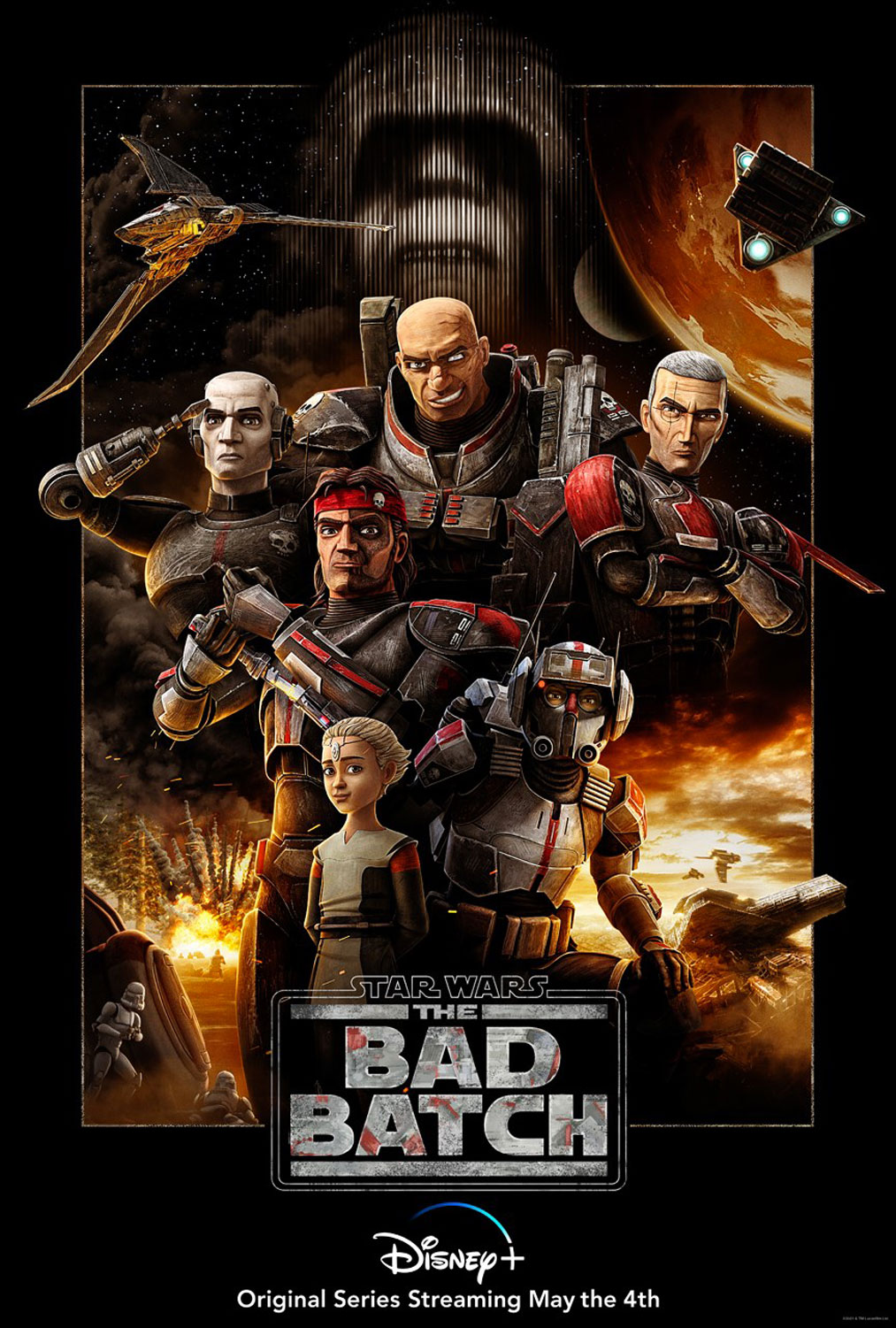
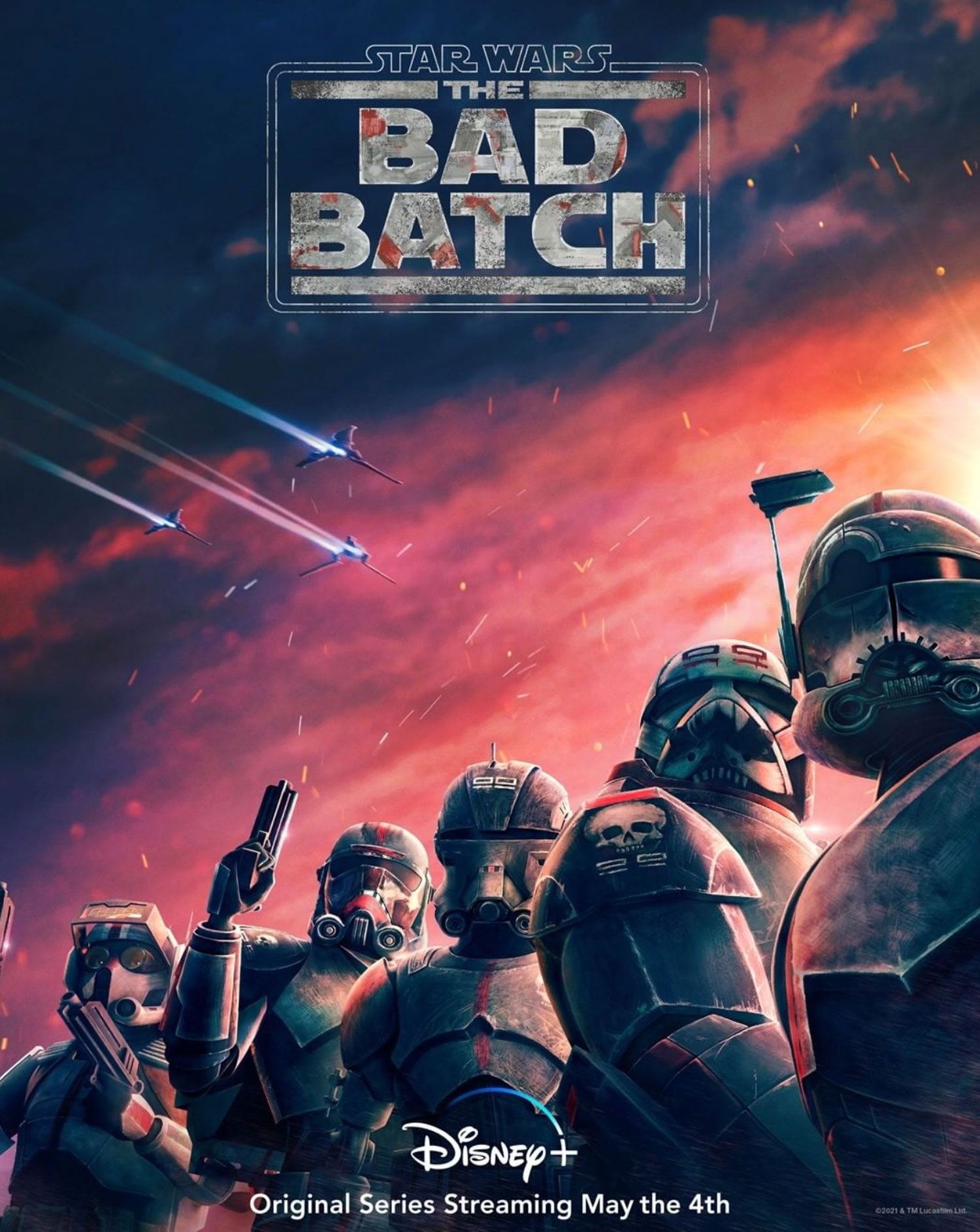
© Vincent Frei – The Art of VFX – 2021
Get ready to go back to a galaxy far, far away with these elite clones for Star Wars: The Bad Batch:
The Animation and VFX are made by:
Lucasfilm Animation
Release Date: May 4, 2021 (Disney+)


© Vincent Frei – The Art of VFX – 2021
Last year, Jonathan Weber explained the work of RISE on the third season of Westworld. Then he worked on WandaVision and Reminiscence. Today he talks about his new collaboration with HBO on the Lovecraft Country series.
How did you and RISE get involved on this show?
In 2020 we jumped on the HBO train for the first time. It was “Westworld – Season Three”, which I also supervised, and it seems that our work was very much appreciated. While finishing the last bits and pieces of it, we’re asked to directly continue the great working relationship with HBO and take on some shots for Lovecraft.
How was the collaboration with VFX Supervisor Kevin Blank?
It was an absolute pleasure working with Kevin and his Crew on the series. He understood that the time frame for the project was tight and that our creatively challenging sequences needed precise feedback. We had multiple, regular cineSync calls per week where we had a very lively exchange of creative ideas. It helped tremendously having him guiding us the right direction designing these worlds from scratch.
What was his expectations and approach about the visual effects?
The space traveling of Hippolyta (the main character of our sequence) brings her to extremely different and odd worlds. The idea was that there is the biggest possible difference in look and feel between each world, letting the viewer just quickly dip into one and already head off to the next location in time and space.
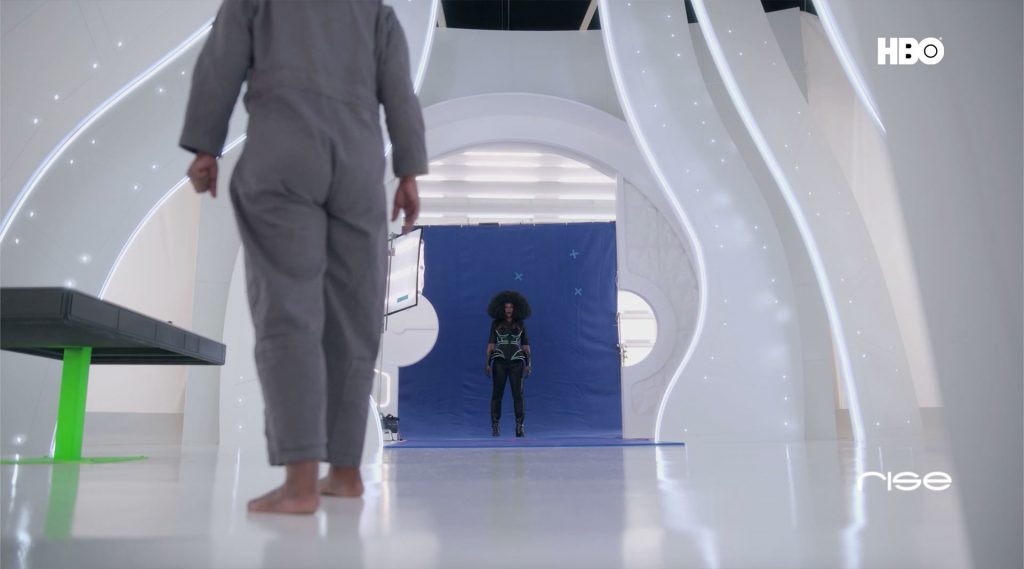
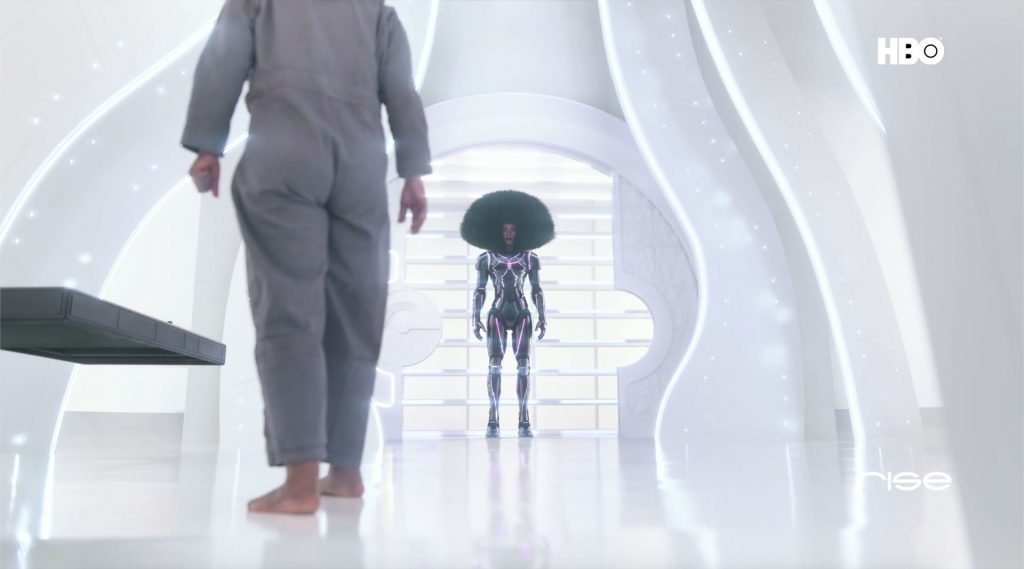
How did you organize the work with your VFX Producer?
Our VFX Producer Katrin Arndt handled crew, scheduling and budget and I had the pleasure of focusing on the images and the methodology. We already collaborated a few times, so it did not take long to set up everything, which was, considering the tight schedule of the show, immensely important.
How did you split the work amongst the RISE offices?
The tasks were split between RISE Berlin and RISE Munich and some additional match move help from RISE Cologne. Munich was focusing on the sequence inside the Prison ship, modelling and designing of the assets and the FX work. Berlin dealt mainly with the Planet surface shots, the matte-painting part and the supervision and coordination. In general, this becomes less and less a severe clean cut rather than smooth collaboration between offices, so it gets pretty tricky to correctly spot out the exact split between the offices.
Also, with COVID of course there is plenty of WFH going on. Big praise to the IT guys making all of that working so seamlessly!
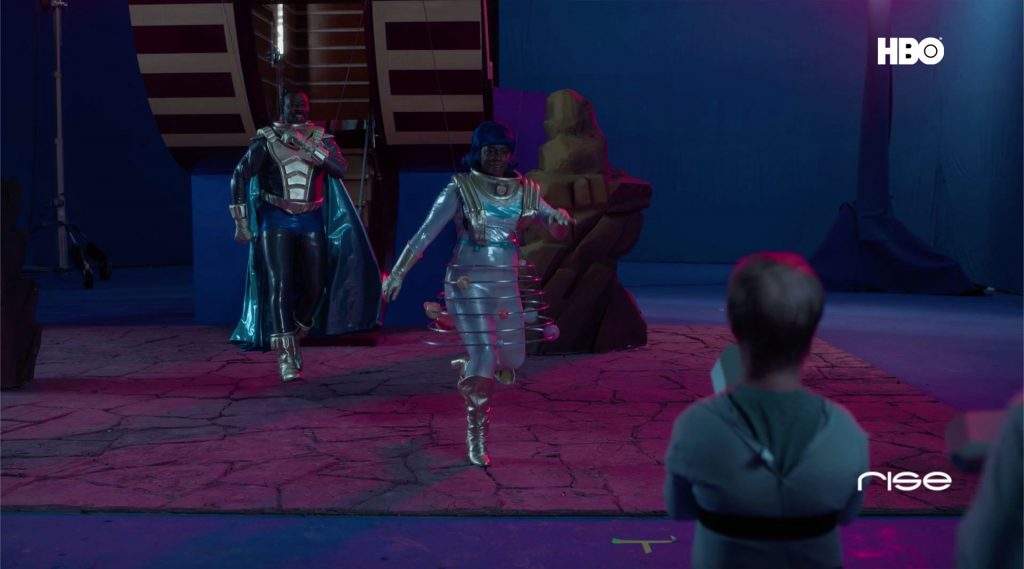
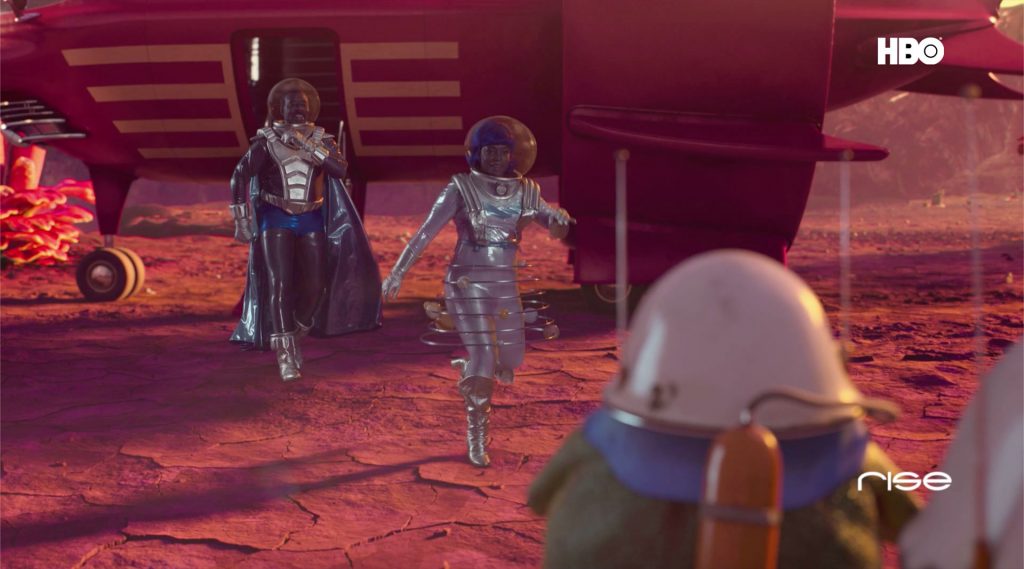
What are the sequences made by RISE?
Our main character Hippolyta is traveling through space and lands on a dark, mysterious planet with the strange name, Planet Earth 504. While wondering where she is, two robots appear and take her to the Prison ship. Inside the Ship Hippolyta is being confronted by Beyond C´est, a 10-feet tall robot lady with a huge afro.
The next sequence takes place on Planet Nelus, a vivid and colourful world, just after the Spaceship has landed. Hippolyta and George get out of the aircraft and encounter three small aliens, Nelusians, who hand over gifts to them. Both Sequences take place in Episode 7 of Lovecraft.
And in addition to that RISE also contributed some smaller, individual shots for Episode 9 and 10.
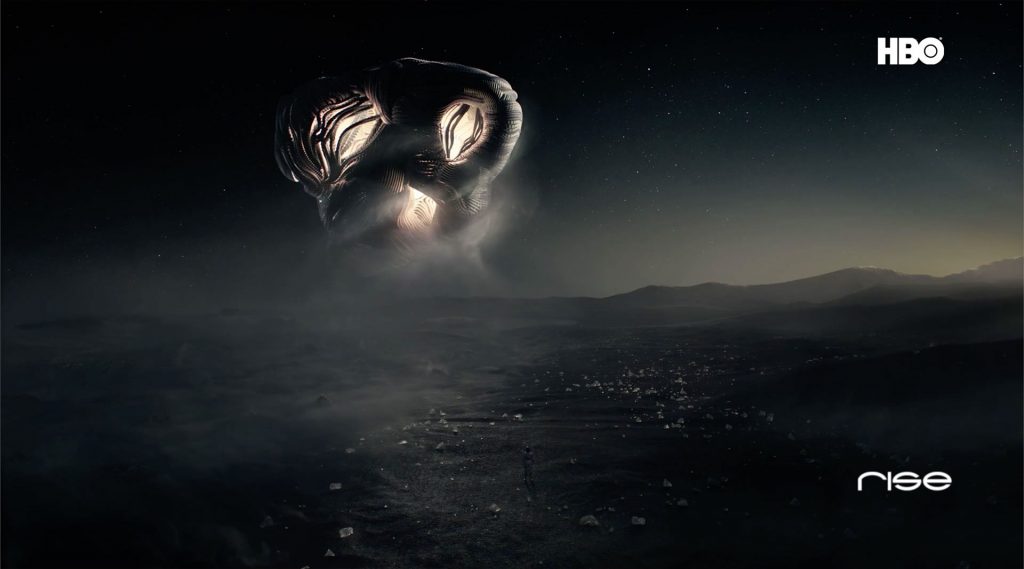
How did you work with Kevin Blank and the art department to design your sequences?
There was a beautiful art department collection of all the sets already, but because of the sheer mass of different worlds and locations of the show, some of them with only one image. It was great to get the discussion going, but there was still a lot of freedom of where to land in the end. We continued with setting up mood boards based on the artwork and the first discussions, setting the tone and colour range for the worlds.
Furthermore, we went through many retro sci-fi comics discussing these with Kevin and then starting with concept art on our side, which we did on a first rough 3D render to make sure we were in the right scale and perspective.
Especially for Nelus it was fun to play around with the bubble gum look of the world, running the plates through some seriously heavy colour treatments and adding all sorts of breathing plants based on weird alien designs.
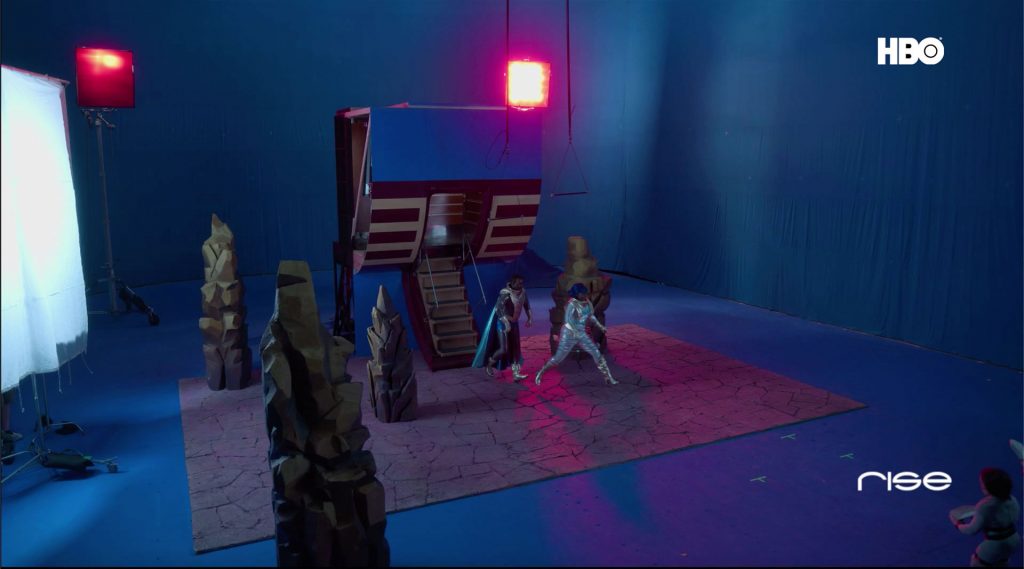
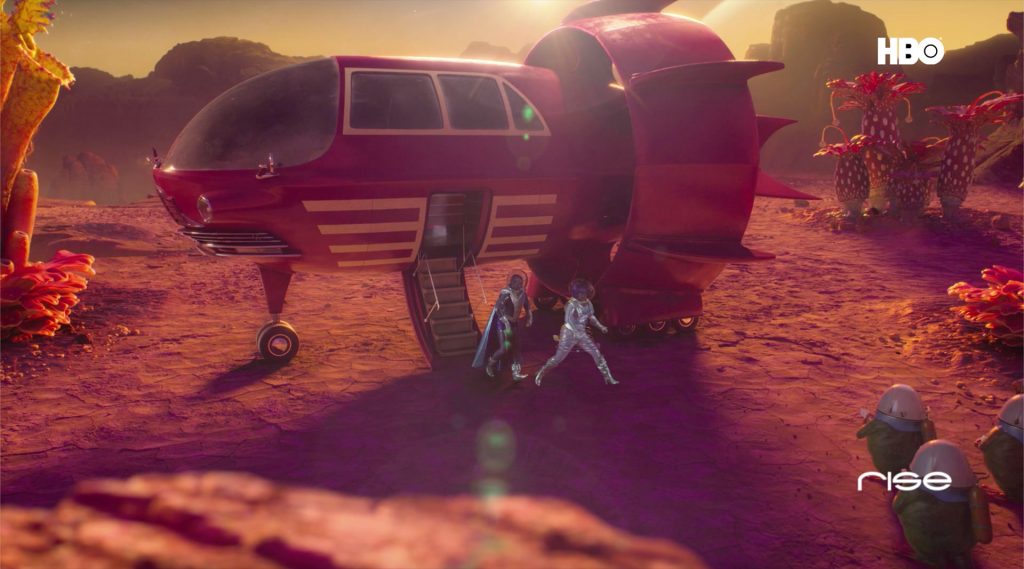
Can you elaborate about the woman arrival on the planet?
Planet 504 is the exact contrast of Planet Nelus. It is gloomy, quiet and very monochrome and full of misty smoke elements with crystals laying around. We found some great references of incredibly unique dark sand beaches somewhere in Island. A very surreal location. And this is what we were going for. Except the far distant horizon we decided to set the all the environments up in 3D, because many of the camera moves were not yet finally decided on when we started with the sequence and it was crucial that we would be flexible when the changes came in late.
As soon as Hippolyta looks up we see the Prison spaceship hovering over the planet surface. This asset already had a very elaborated concept of a gigantic face-like structure with big lights.
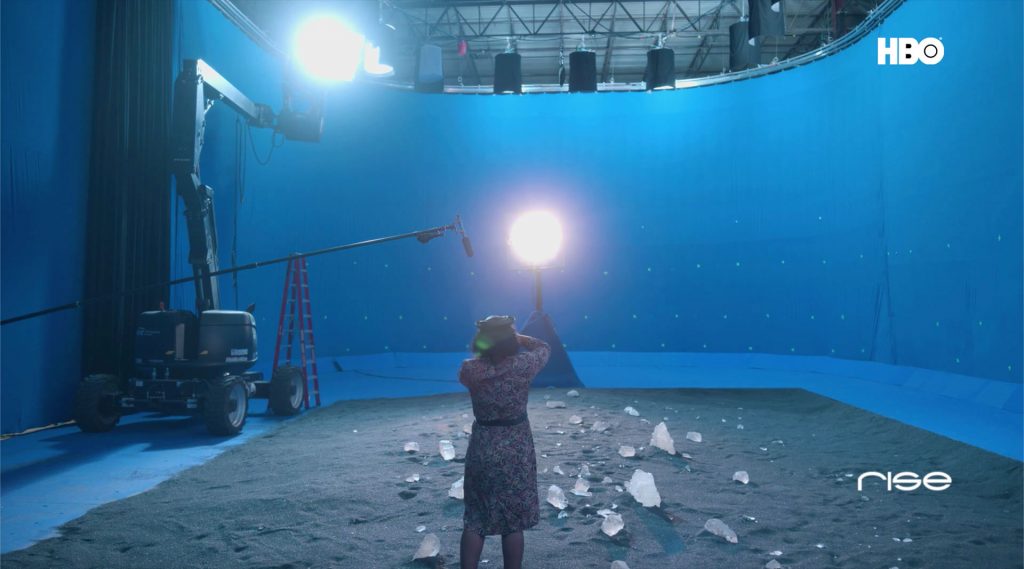
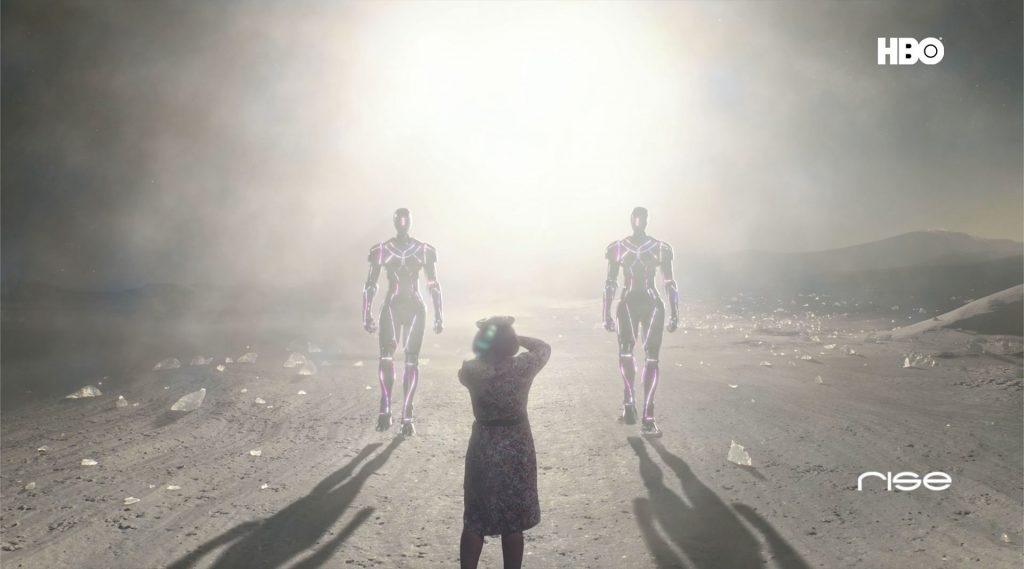
How did you enhance her massive afro hair?
After some quick size and shape wedges for the afro we started investing some research time for the setup of the afro. We ended up with a combination of classical hair tools (grooming, guide curves) and more unconventional methods for the frizzy hairs using our own deformers to be able to solve the iteration loops a bit quicker. We had three different curliness and frizziness levels to choose from depending on the distance of camera and angle.
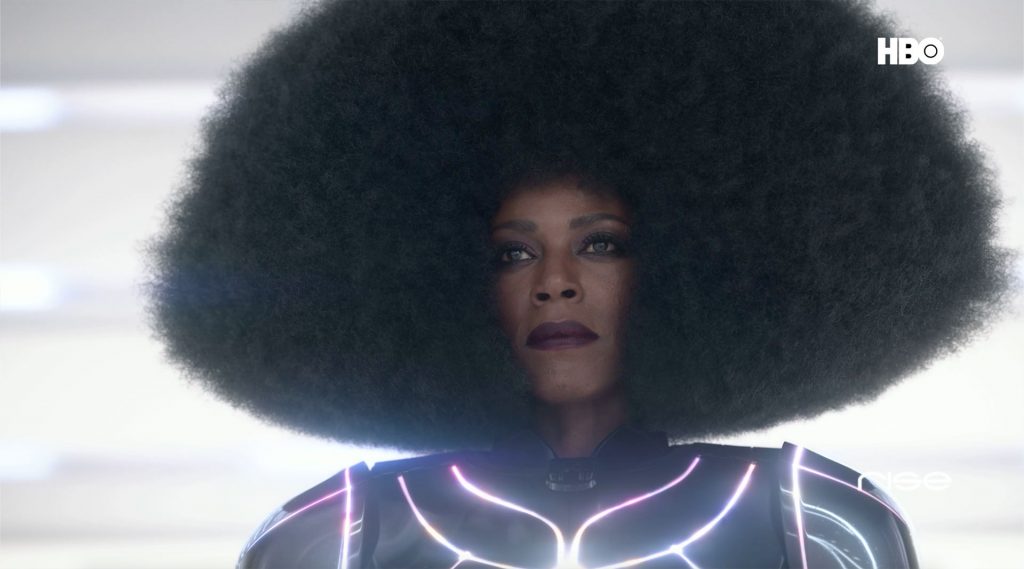
How did you create the spaceship?
Spaceship Woody is based on the Hero Car of the series, a 1948 Packard Station Sedan. This car has a very characteristic chubby-cheeked design with a big chrome grill going over the whole front of the car and very unusual wooden side panels. It was requested to implement these into the spaceship design making sure the viewer can identify the spaceship as a retro-futuristic version of this car. In the end we even added the hood ornament and a classical steering wheel. We had a blast tweaking the design of the little blobby spaceship to the very last moment before hitting the render button.
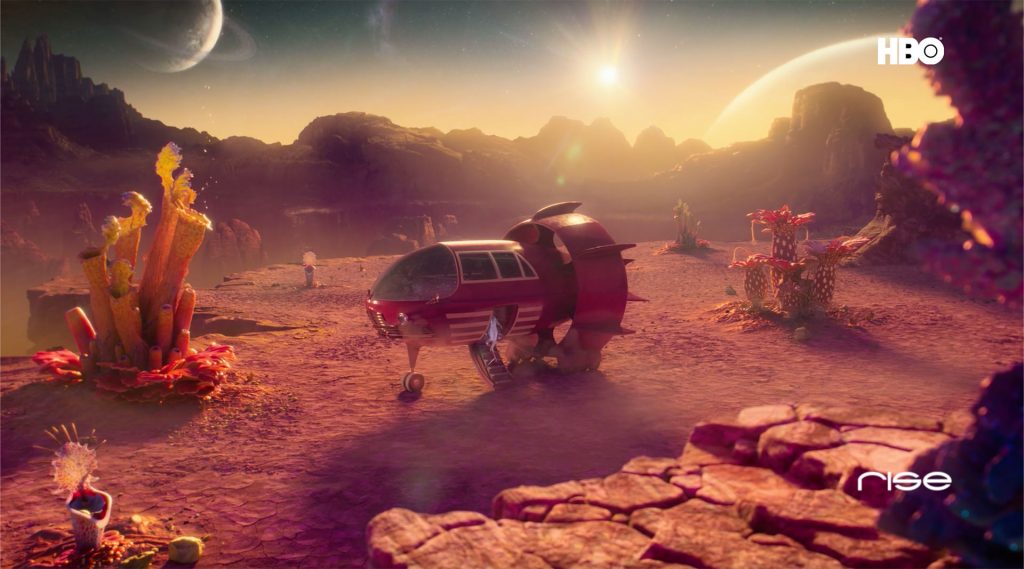
Can you explain in detail about the design and creation of the cute aliens?
When we started working on the design of the Nelusians, they existed only in one smaller artwork image of the aliens holding the gifts. But that image was loved by everyone already. The little guys had so much personality. The tricky part for us was making sure to keep the characteristics of the artwork while ensuring the 3D model operates smoothly when animated. One of the problems were the extremely short arms of the artwork. The Nelusians simply could not perform the task of handing over a gift with their little arm stumps. So we tested a little until we found the right balance of arm length and thickness without changing their character too much.
For the skin textures we researched many frog images, looking at a wide range of vibrant textures. But going further into the amphibian direction did also not work, because once they got too slimy, they lost all their cuteness instantly. Another important element was their walk cycle. We had to test and check out many different speed and weight wedges until we found the right feel for the correct Nelusian waddle.
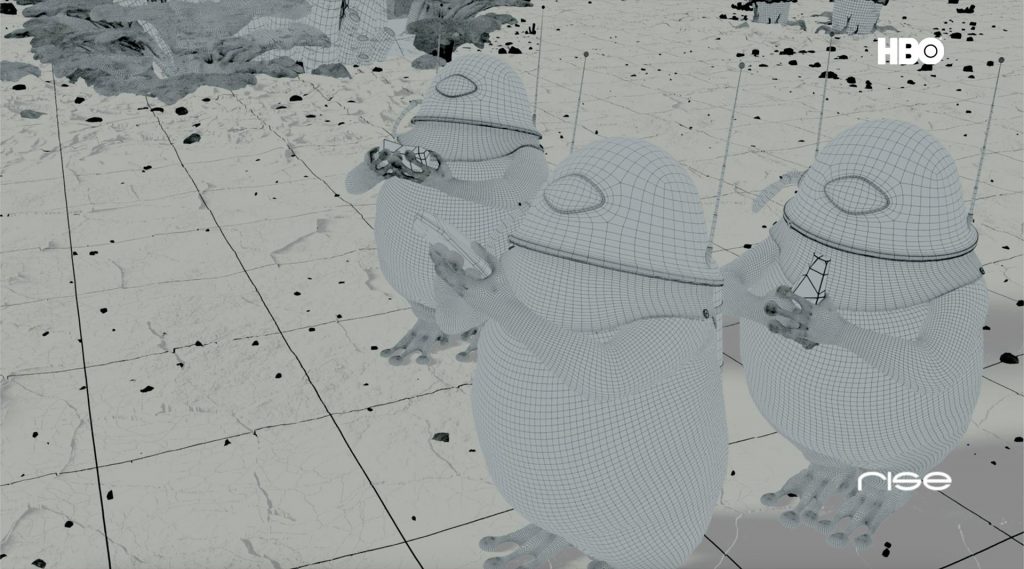
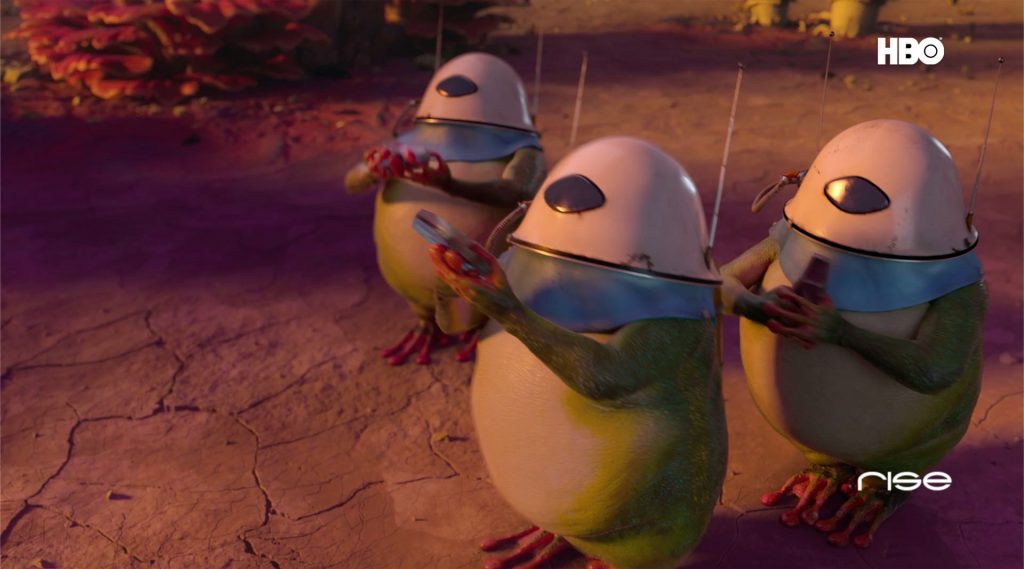
Is there something specific that gives you some really short nights?
The short time frame for the whole show added some pressure, but that was nicely absorbed by the extraordinary team working on the show.
What is your favourite shot or sequence?
You’ve got to love the little Nelusians waddle into frame presenting their gifts to the foreign travellers.
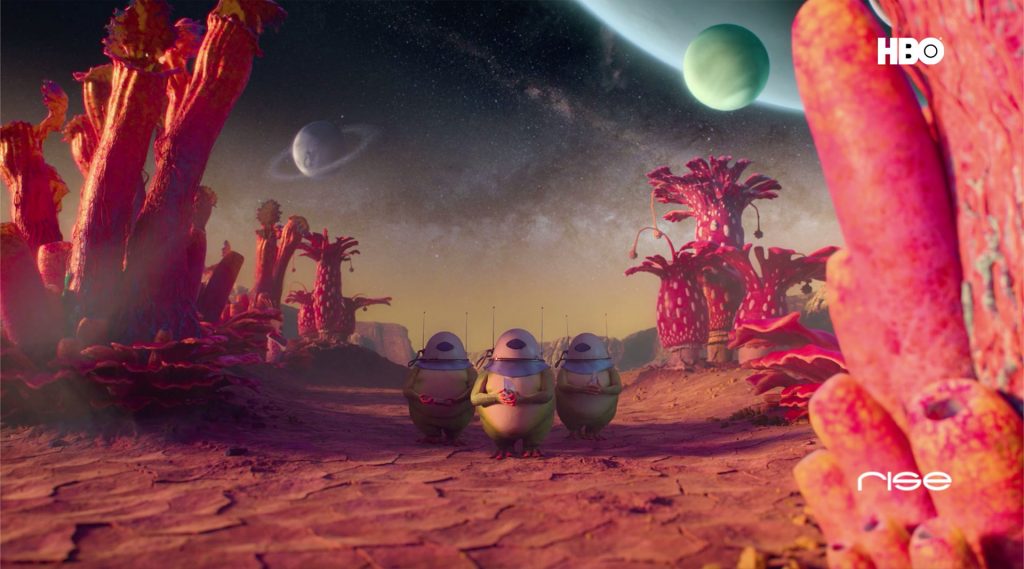
How long have you worked on this show?
Two and a half months for the main part of the shots.
What is the VFX shots count?
50 shots. This does not sound like a lot, but considering these worlds needed to be created from square one just for a few shots and off to the next one, they were enough.
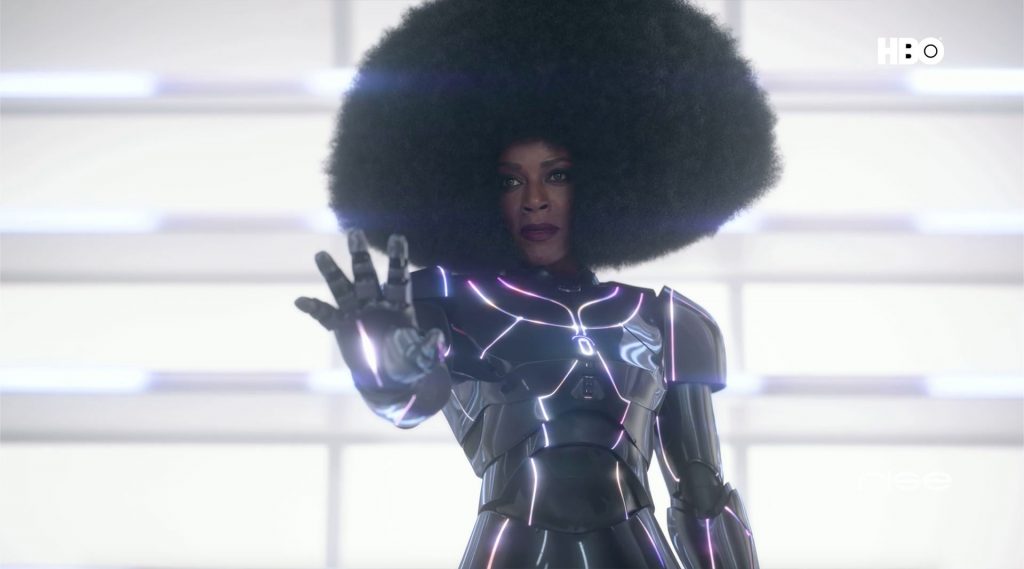
What was the size of your team?
Around 50.
What is your next project?
I slipped directly into Marvel’s WandaVision that kept me terribly busy and is also the reason why this interview is a little late.
A big thanks for your time.
// Lovecraft Country – VFX Breakdown – RISE
WANT TO KNOW MORE?
RISE: Dedicated page about Lovecraft Country on RISE website.
HBO Max: You can now watch Lovecraft Country on HBO Max.
© Vincent Frei – The Art of VFX – 2021
Russian studio Main Road Post has released this VFX Breakdown about the Games sequences from the blockbuster sci-fi movie, Cosmoball:
WANT TO KNOW MORE?
Main Road Post: Dedicated page about Cosmoball on Main Road Post website.
© Vincent Frei – The Art of VFX – 2021
Prior to my interview tomorrow, let’s have an intergalactic trip to discover the work of RISE on the HBO series, Lovecraft Country:
WANT TO KNOW MORE?
RISE: Dedicated page about Lovecraft Country on RISE website.
HBO Max: You can now watch Lovecraft Country on HBO Max.
© Vincent Frei – The Art of VFX – 2021
Yeah! Get ready for tons of actions with this new collaboration between Director Guy Ritchie and Jason Statham for Wrath of Man!
The VFX are made by:
MagicLab (VFX Supervisor: Michal Krecek)
Director: Guy Ritchie
Release Date: May 7, 2021 (USA)
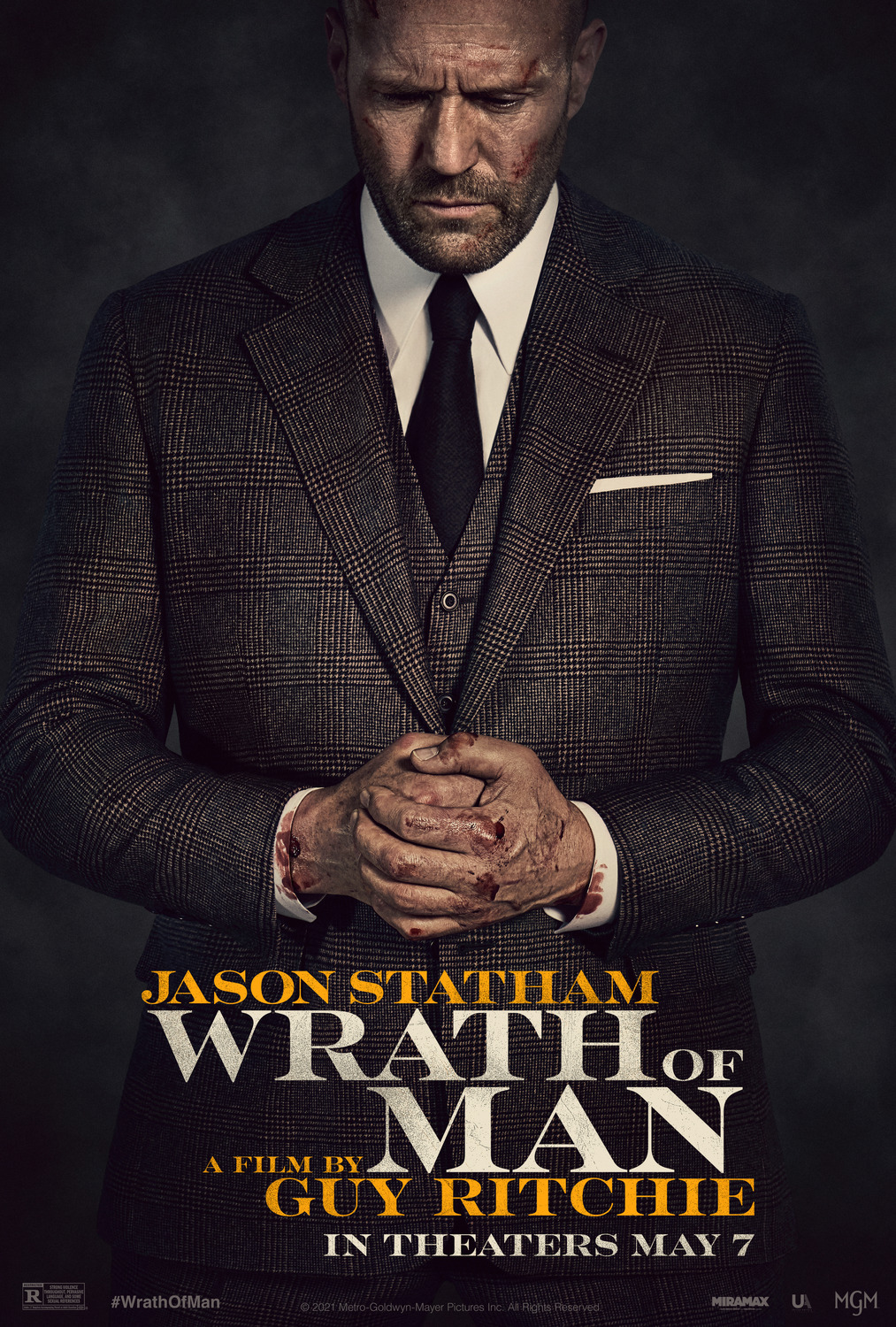
© Vincent Frei – The Art of VFX – 2021
Ralph Maiers has been working in visual effects for over 25 years. He has worked on many shows including Night at the Museum: Secret of the Tomb, Crouching Tiger, Hidden Dragon: Sword of Destiny, Altered Carbon and Lost in Space.
What is your background?
My background includes Photography, writing, producing, motion control, motion capture and 3D environment creation. I began my visual effects career as a digital compositor and worked at many of the hi-end visual effects companies in Hollywood during the late eighties and nineties.
I tend to gravitate toward natural FX, real lens depth, and queuing. I am a classically trained oil painter and sculptor, so I have a long history of imitating reality and a technicians well-trained eye. The long history in the industry informs my choices and helps project the way forward on both sequences and individual shots.
How did you and Mr. X get involved on this series?
Marvel approached us to begin some R&D on a scene for Episode #109. The initial work was to create some Desiccating Witch tests and quickly evolved into the Origin story for Agatha Harkness that the WandaVision series pivots around.
How was the collaboration with Director Matt Shakman and VFX Supervisor Tara DeMarco?
The collaboration with both the show side supervisor (Tara DeMarco) and Matt the director was energetic and fun. We spent many cineSync sessions on explorations in varying approaches to both the witch’s destruction and the overall magic envelope that they inhabit during the flashback to the 1600’s Coven.
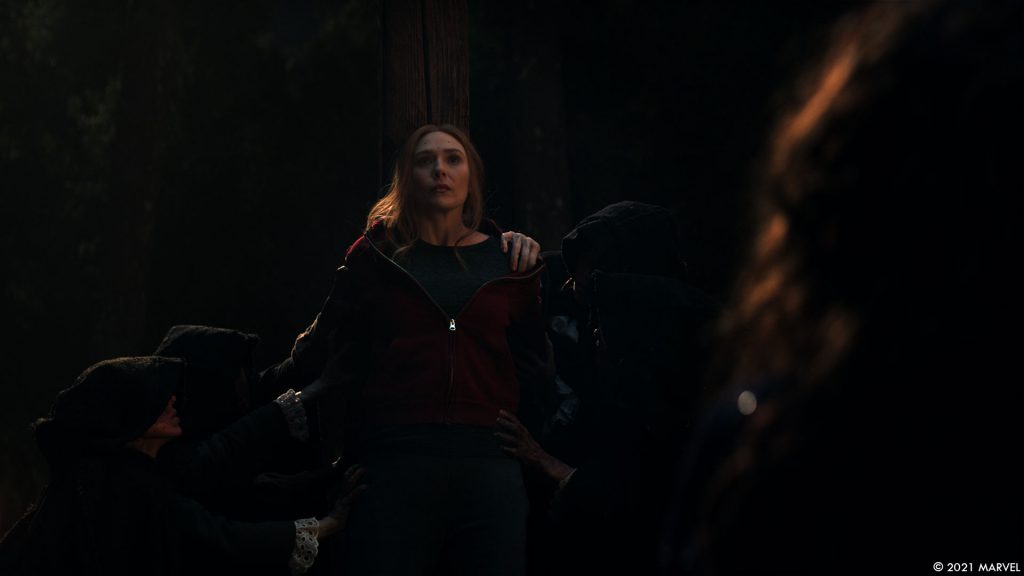
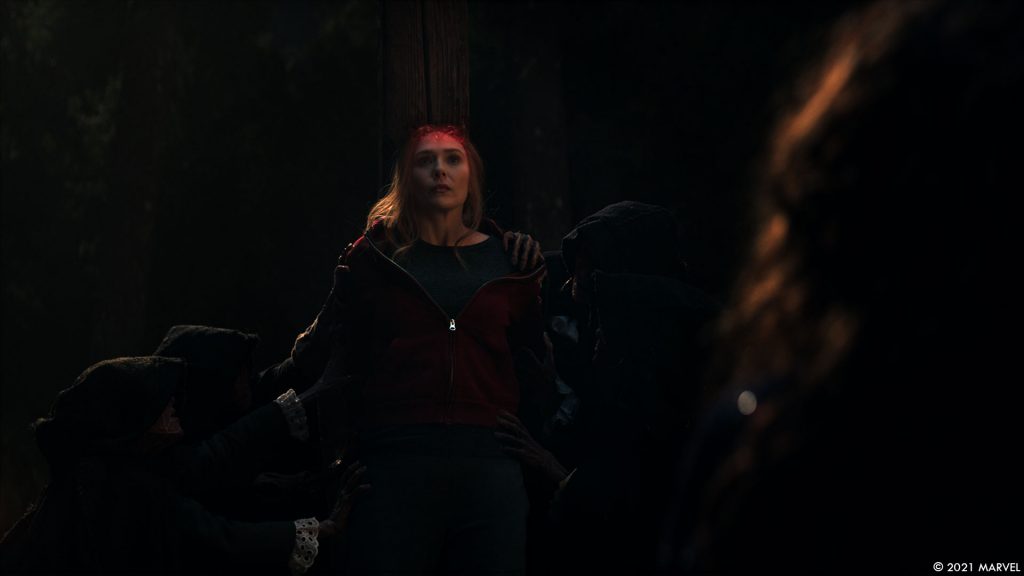
What was their approach and expectations about the visual effects?
The scene is quite a dark moment in the Marvel cinematic universe. The Witches are about to execute Agatha at a young age of approximately 18 years old. The Coven has discovered her powers are uncontrollable and therefore need to be extinguished. The evolution of the scene was toward a darker theme and so we walked softly into the horror genre. Of course, the balance of family friendly mysticism was a governing factor in all discussions. Matt and Tara helped guide us through the dark and scary but not too scary world of Agatha’s twisty past. Matt’s color and tone choices allowed for a fairly quick understanding of what was happening but kept the scenes from going too deep into the horror aspect of the coven.
How did you organize the work with your VFX Producer?
The Show days at Mr. X are calendarized into morning meetings for Composite and the disciplines of CGI creation. So the daily schedule is Modeling, Rigging, match move and tech animation in half hour or hourly time blocks depending on the needs of the departments. The Composite discipline is usually split into two sessions for iteration notes, one early and one later in the day. Lighting and Look Dev are sprinkled into the mix for review when they become factors for discussion. The department meetings happen at fixed times throughout the day to keep everyone in constant communication as the elements evolve and approaches change over the course of the shows. The shots are broken into Key and sibling shots. The Key shots are chosen based on the importance for the sequence and the corresponding camera or action that drives story. The secondary shots are then chosen based on their relationship to the Key shots. Similar angles and or FX needed are categorized into sub-groups and follow the development of the Key shot they mirror or have similarity too.
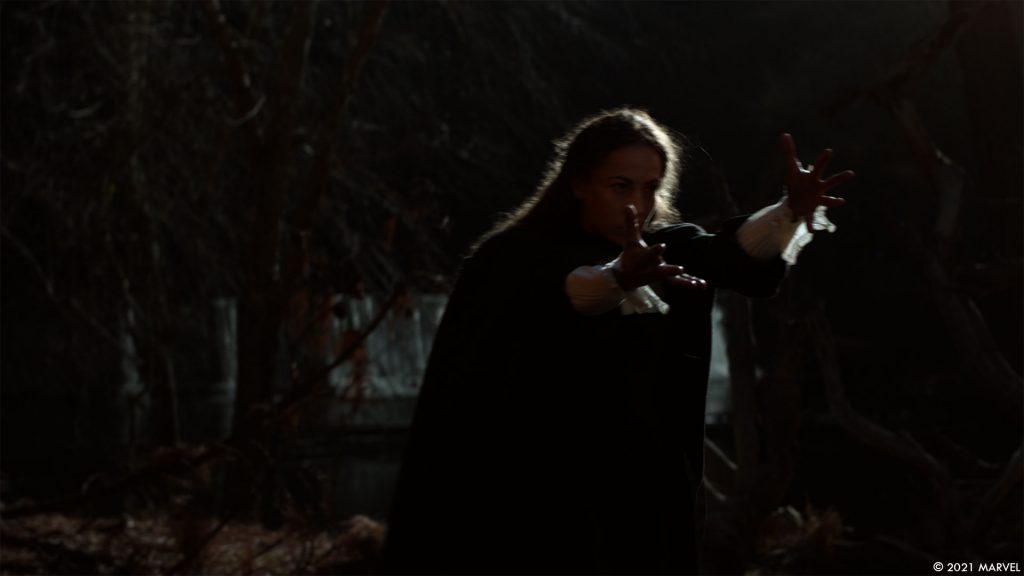
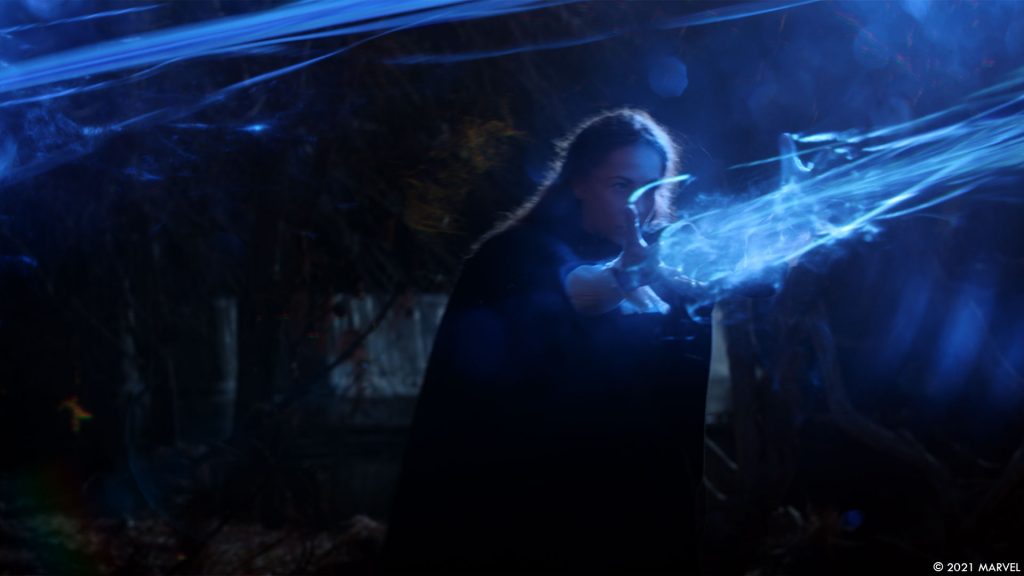
How was split the work amongst the Mr. X offices?
The Bangalore offices did the heavy lifting with the large number of rotoscopes, match moves, and composite tasks involved. The Montreal team did composite and supervision primarily.
What are the sequences made by Mr. X?
The witch coven sequences in episodes 109, 110.
How did you work with the art department for the Agatha’s magic beams?
Mr. X created some concept design initially provided by one of our concept designers, Gaetan Borneuf. These initial concepts where well received by the production side team and Matt. We used these concepts as our initial guide and developed the design multiple times as the briefs where adjusted. The Concept designs helped us navigate the emissive tendrils look dev while we worked away technically in FX to achieve those visual goal posts.
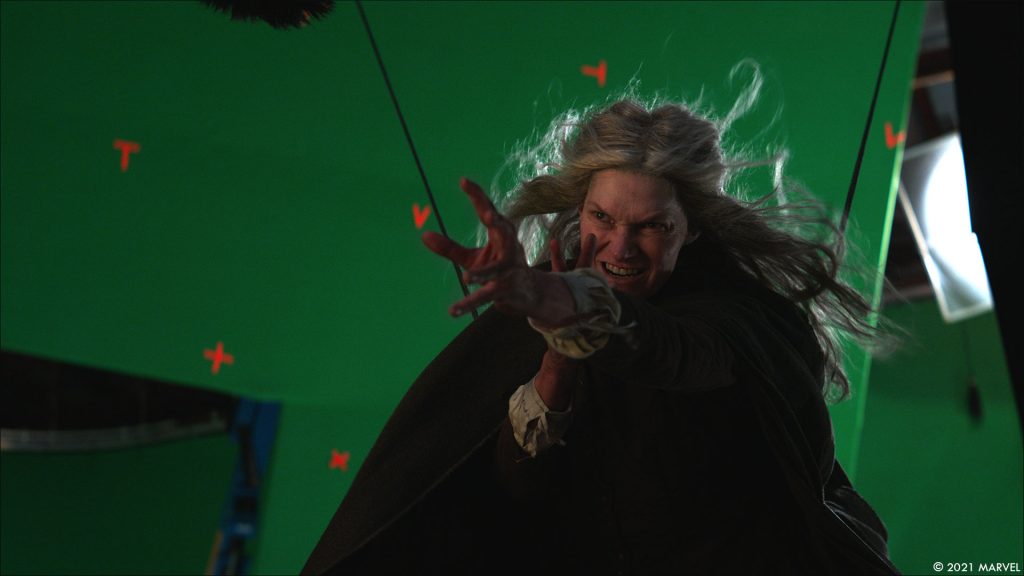
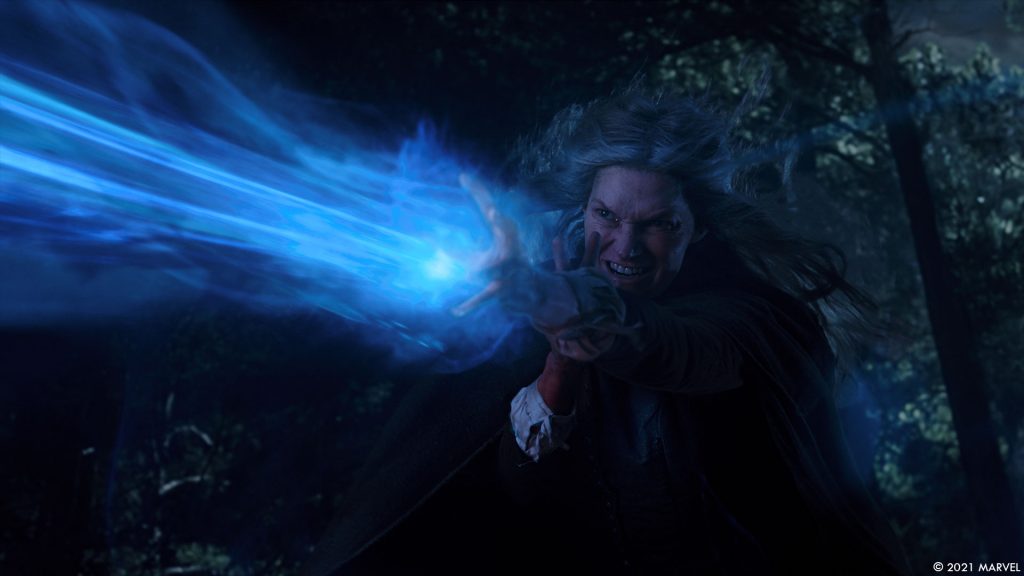
Can you explain in detail about the creation and animation of these magic beams?
The Beams were created in Houdini utilizing a wide array of particle advection techniques for the different tendril like twisting streams that occur throughout the EP. #109 sequence. The initial setup was poly line based and advection occurred along the tangent of the poly lines and forces were used to direct the emissions along the associated paths.
The origins had emissions that we utilized to establish the conical tear drop shape that showed directed force in the direction of Agatha. At the impacts we created a shunt and kill for any bouncing particles to keep the attack feeling lethal and directed into Agatha.
We were careful not to make this too invasive as we were playing to a family friendly viewership. The beams went through many design phases from a more languid colorful ethereal sinusoidal wave to a dark simplified color pallet with a significant directional advection. Impacts on Agatha where also explored, ranging from destructive emulation events to a less intense swirling contact point that we used to portray a penetration without too much direct vivisectional display. Mr. X used a tight match moved interactive lighting pass to reveal the under skin and under garment glow of beam penetration.
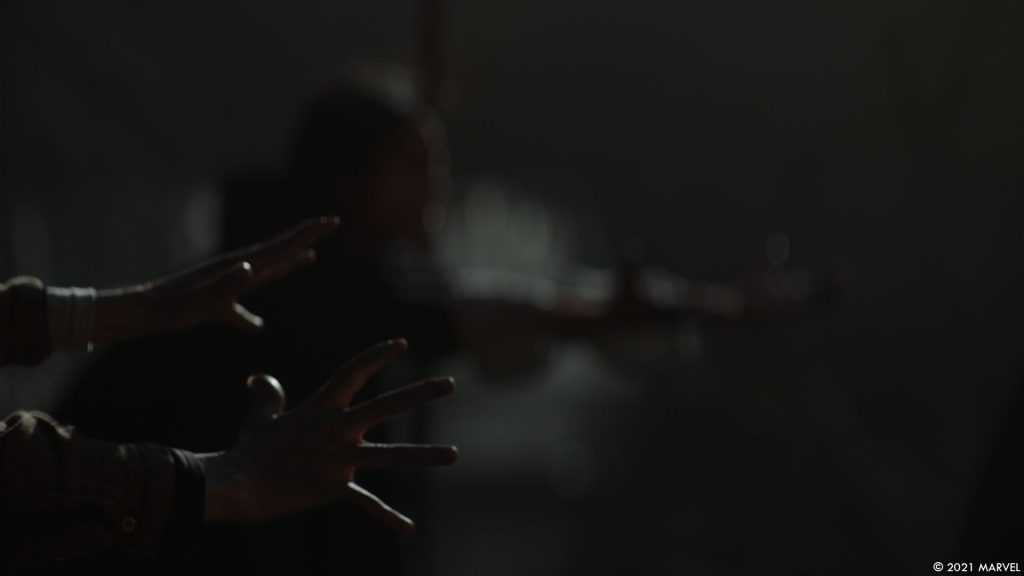
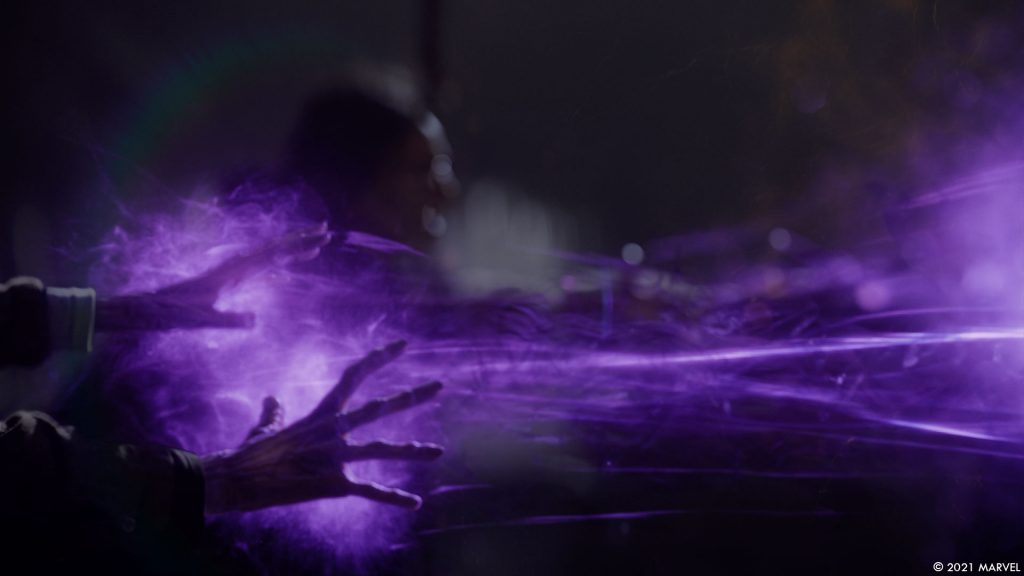
What was the main challenges with the magic beams?
Both sequences 109 and 110 were a creative and technical challenge for the studio and team. The sequences involved match moving up to nine animated doubles and creating large caches of particle FX in Houdini. The cache sizes and volumes were carefully controlled by the team to keep these large scenes from being un-manageable. The particle cache sizes ranged in the 120 million to 150 million so balancing scene detail and overhead was a priority. The sculpts on the models were ranging in the 100 million polycount. So, the scenes where rendered in separate layers for efficiency.
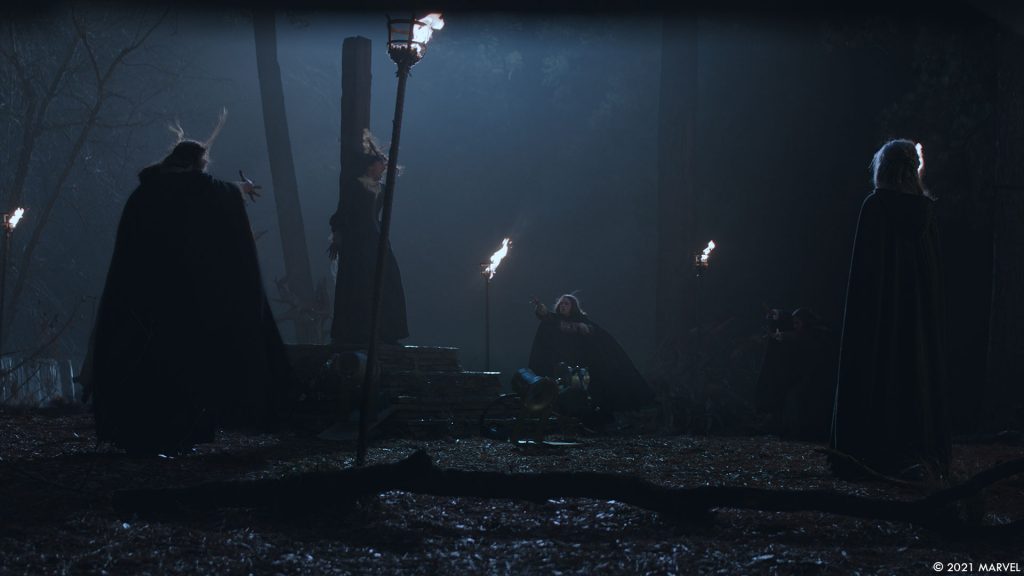
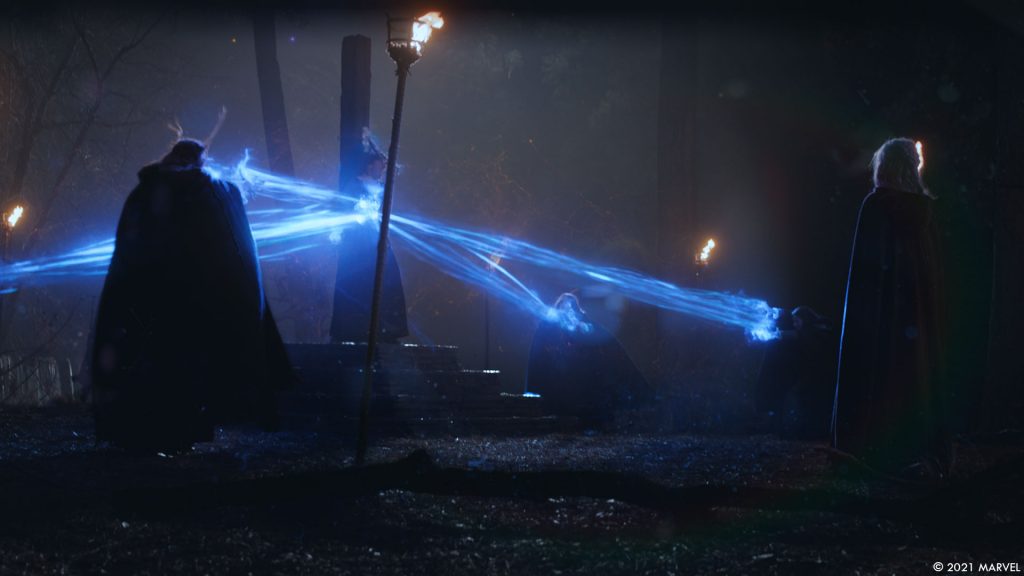
How did you create the effects when Agatha stole the life of the other witches?
Agatha’s signature tendril magic was developed with Matt and Tara’s guidance. The color values and twisting smoky tendril were carefully developed in the FX department by Michele Alessi and Erik Rasmussen. The direction was to make them creep and envelope around the other witch’s magic. This involved taking the beams that had already been created and then creating a fresh volume per beam and emitting the enveloping Agatha magic running against the force of the beams attacking her. Matt and Tara where careful to simplify color pallet so that this was very clear. Our Compositing Team in Bangalore, led by Bhavik Mehta worked to develop differences in opacity and texture and variance in speed to help tell that vary important Agatha moment. Her magic absorbing others power and making it succumb to her will is the key to her Origin Story, and the fulcrum for the WandaVision story arc.
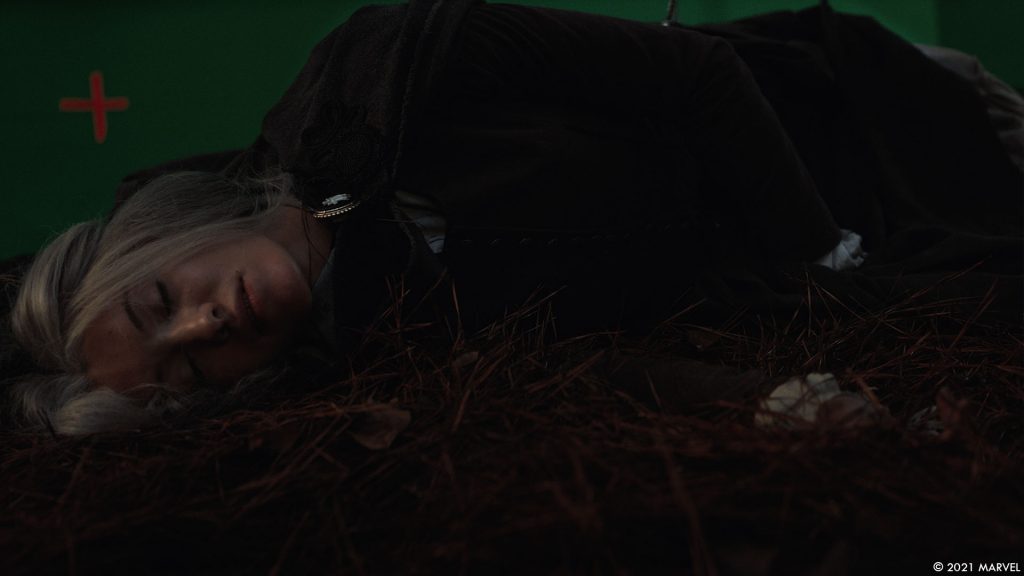
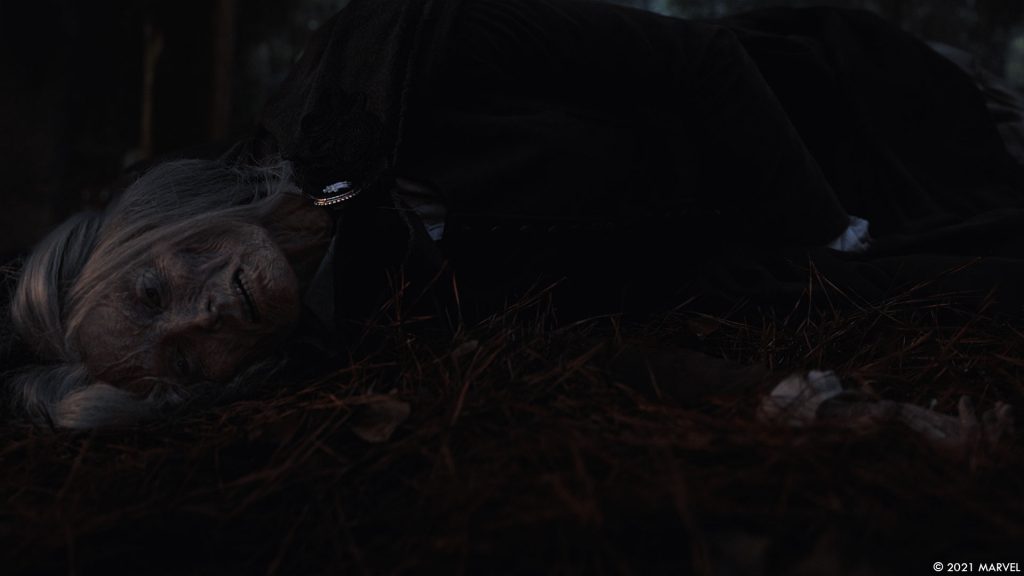
Can you tell us more about the digital double’s creation?
The primary challenge for our sequences was creating multiple Desiccation events for the witches as they begin to lose the battle with Agnes. All witches were scanned by production and provided to Mr. X for rigging, texture and animation. The 8 witches where match moved and 4 were identified for tight skin tracking in our tech animation department for interactive flesh glow and desiccation growth on their flesh. Multiple levels of sculpt where created for these and blend shapes were rigged to create the transitions from level to level of desiccating flesh.
What kind of references and indications did you received for these effects?
At the kickoff meeting in April, Tara showed Mr. X the Walter Donavon sequence from “Indiana Jones and the Last Crusade”. This Mummification or Desiccation was the basis for our Witch withering look. The mood and tone of the scene was defined as dark and scary but not too dark for our family friendly audience. Mr. X spent the next 8 months working on the R&D and scene development. From concept to final FX the Desiccation took us through the refinement of the withering limbs and faces.
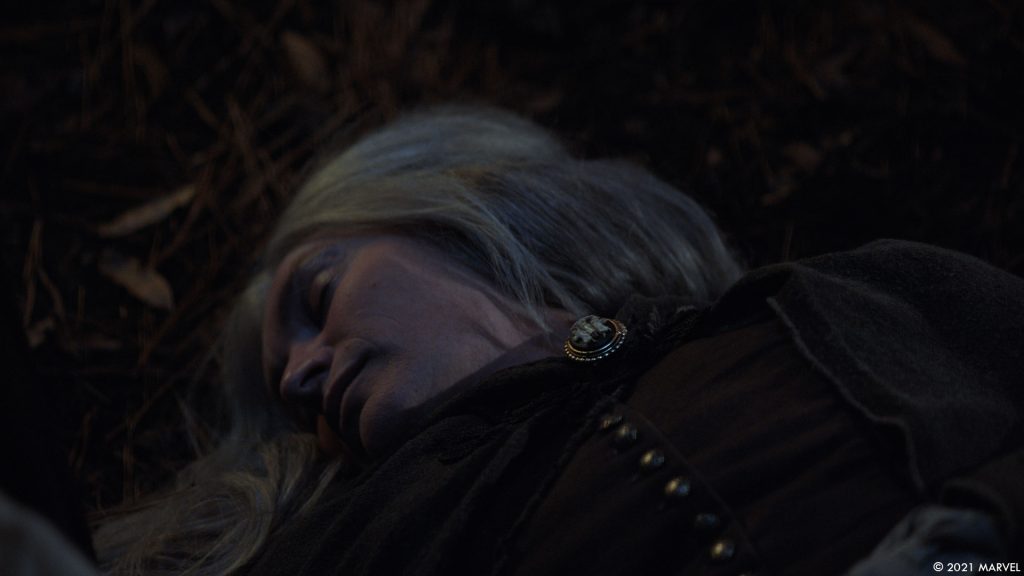
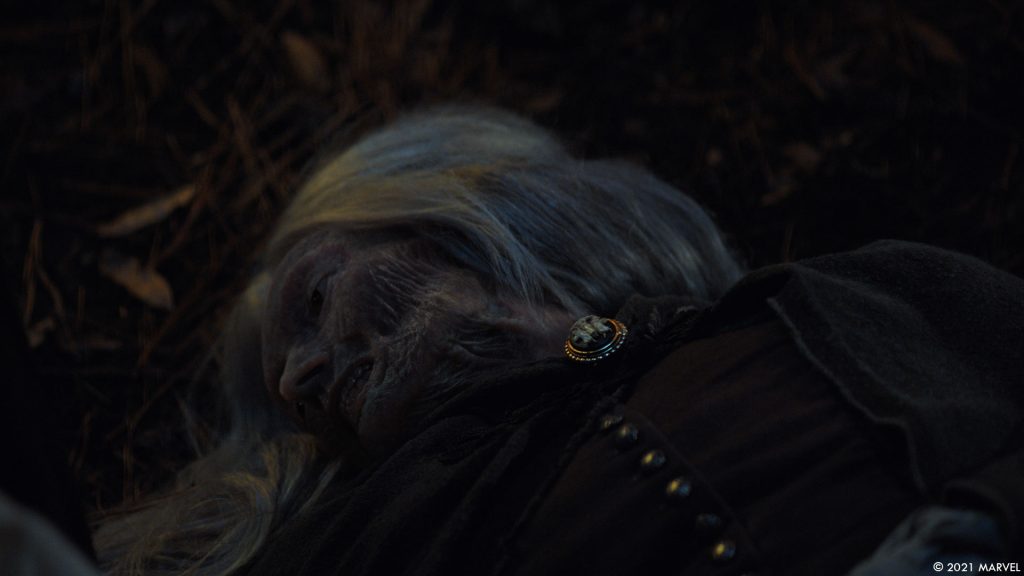
How did you create the Coven environment?
The Coven environment was Lidar, scanned by the production. The Mr. X environments team decimated the mesh and simplified the geo to create something that would support the level of detail we required. These scans are often 100’s of millions of polygons and often they need to be imported as individual slices and then assembled into simplified forms for reflection maps and environmental lighting purposes. The ground was separated and utilized as the anchor points for our witch positions and light rigging.
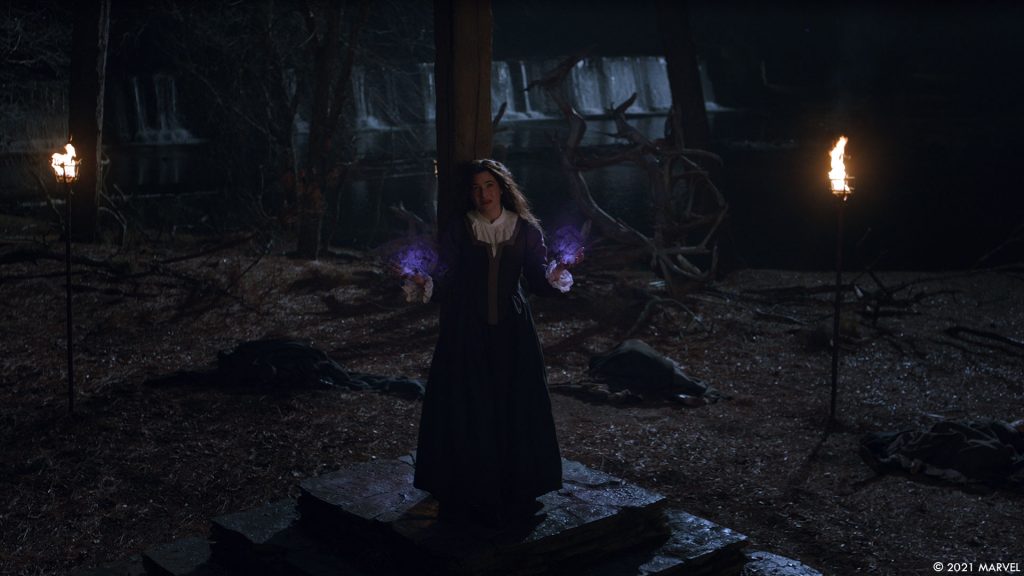
Which sequence or shot was the most challenging?
Together the coven of witches and their emissive magic powers created technically challenging scene scale and complexity. The size of the scenes and the individual layers of FX were the most demanding part of these sequences. The look development and attention to detail in the lighting and render where some of the more subtle but sophisticated elements of the sequences.
What is your favorite shot or sequence?
I personally enjoyed the EP #110 sequence. The desiccated witches attacking Wanda. The accomplishment is understated but a personally satisfying triumph.
What is your best memory on this show?
The team worked closely with show side Supervisors Tara DeMarco and Sandra Balej on both the development and design of the magic interactions. The studio was a joy to work with and very open to the creative process in development of ideas and elements that opened the magic realm of the coven environment.
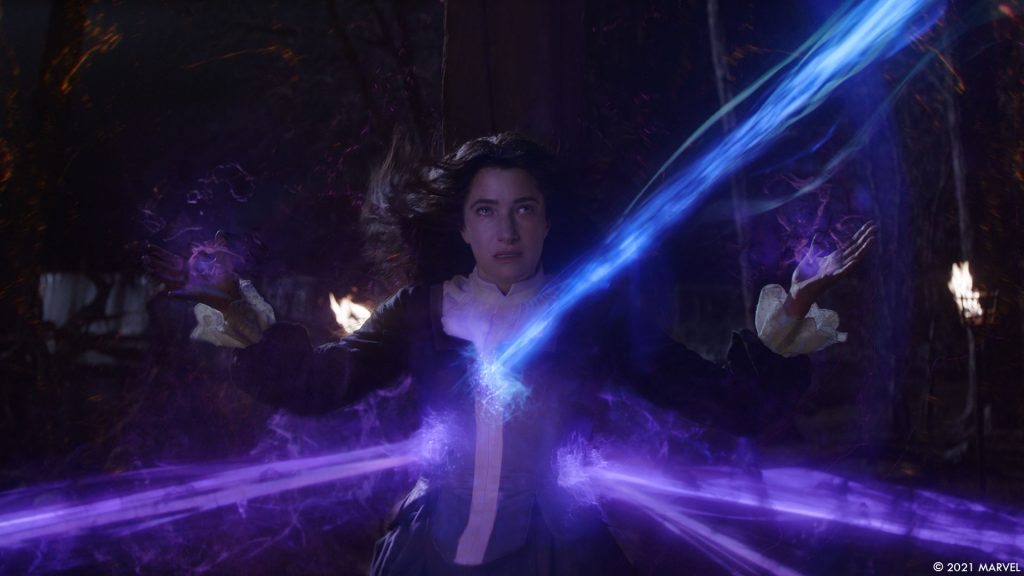
How long have you worked on this show?
We were on the two sequences approximately 10 months start to finish.
What’s the VFX shots count?
Final count was 152.
What was the size of your team?
The core team was approximately 28 people in Bangalore and 8 people in Montreal not counting the management staff of 10 or so people. The bursts of roto, prep and match move personnel would take us up into the low 120’s for weeks at a time.
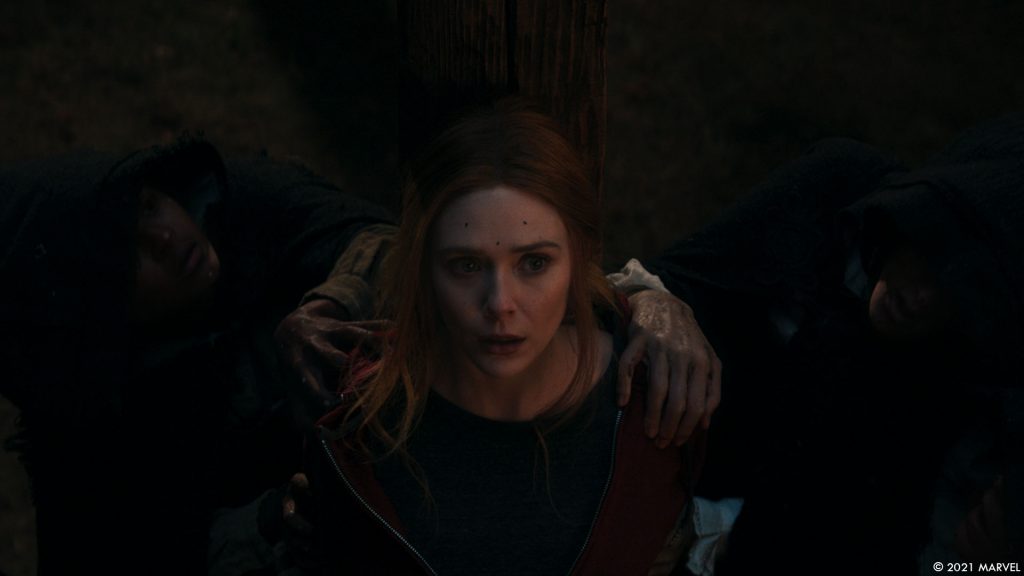
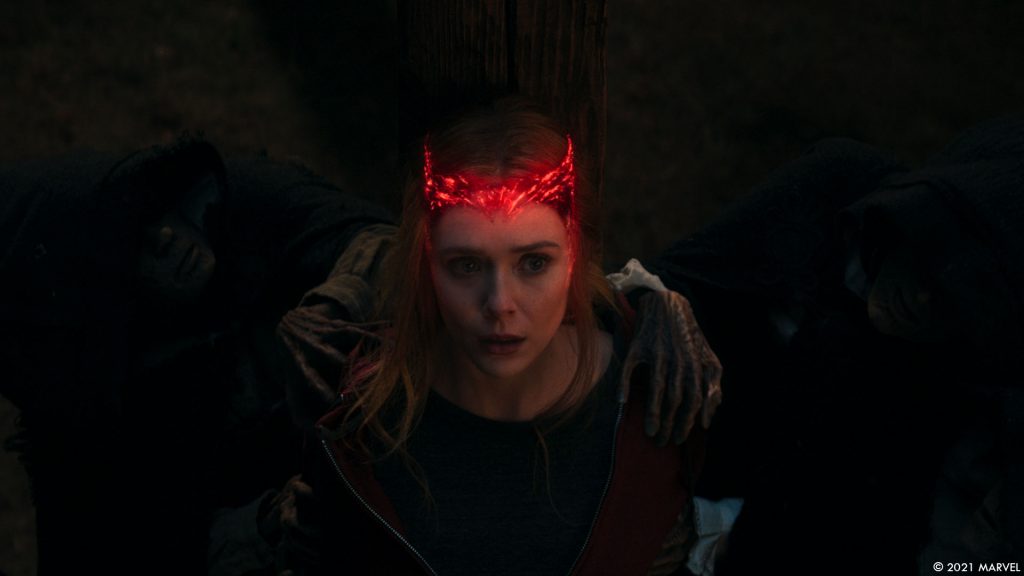
What is your next project?
I can’t say unfortunately!
What are the four movies that gave you the passion for cinema?
Blade Runner, Silent Running, and any Italian cinema Films I ran across in my younger years.
A big thanks for your time.
WANT TO KNOW MORE?
Tara DeMarco: Our interview of Overall VFX Supervisor Tara DeMaco about WandaVision.
Mr. X: Dedicated page about WandaVision on Mr. X website.
Disney+: You can watch WandaVision now on Disney+.
© Vincent Frei – The Art of VFX – 2021
While waiting for the new season of The Expanse, let’s have a look back on the VFX work made by Spin VFX on the first five seasons (click on the picture below to watch it):
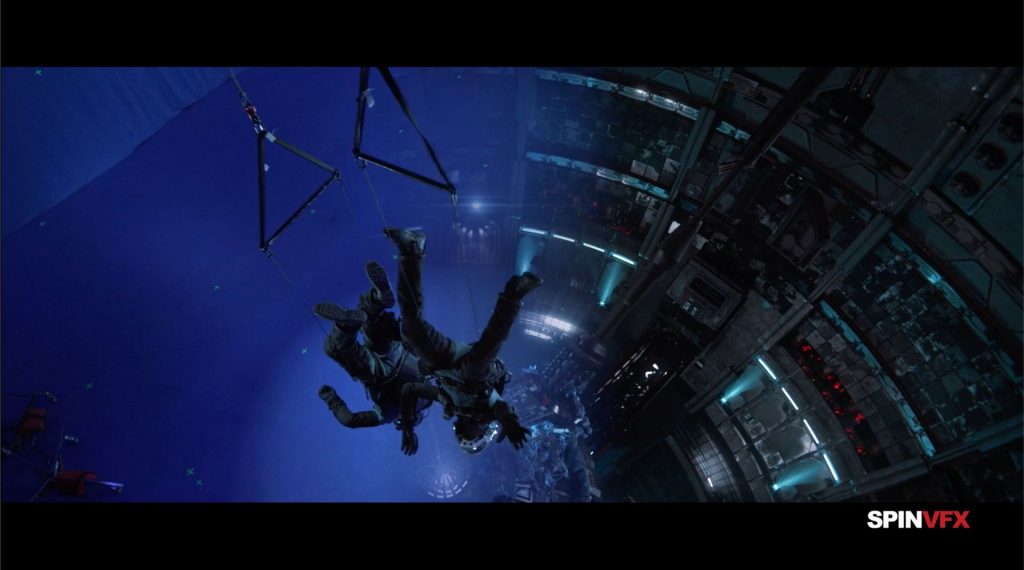
WANT TO KNOW MORE?
Spin VFX: Dedicated page about The Expanse S1-5 on Spin VFX website.
© Vincent Frei – The Art of VFX – 2021
Let’s discover snowy mountain peaks, a city at war, jungles, and forgotten temples on a mysterious world created by the teams of Platige Image in this CG trailer for the Square Enix video game, Outriders:
WANT TO KNOW MORE?
Platige Image: Discover more informations about Platige Image work on this CG trailer for Outriders.
© Vincent Frei – The Art of VFX – 2021
Damien Thaller has over 20 years of experience in visual effects. He has worked in many studios like ILM, Rising Sun Pictures, Image Engine before joining FuseFX in 2020. He has worked on projects such as Logan, Lost in Space, Fantastic Beasts: The Crimes of Grindelwald and Game of Thrones.
What is your background?
I’ve been creating art since I could hold a pencil. I originally studied traditional art & design while working in the gaming industry in the 90’s with a focus on character & vehicle design. The gaming industry back then was very exciting transitioning from PC to early PlayStation & XBox consoles, here I shifted and broadened into a more 3D environment that led me to film. In film I fell into the world of creating environments with matte paintings & 3D builds. Through my time as an artist I shifted into VFX art direction & supervisor roles in film and episodic.
How did you and FuseFX get involved in this series?
Jon Cowley, the FuseFX head of Studio, had an excellent working relationship with Darren Bell, the VFX producer that brought the show into the studio for season 1. I had worked with Jon in the past, and I was wrapping the last season of Game of Thrones as well as Joker when Jon and I began chatting about coming onboard as VFX supervisor for Snowpiercer Season 2. The timing was good, I met the team and we went from there!
How was the collaboration with the showrunners, directors and VFX Supervisor Geoff Scott?
Showrunner and producer Graeme Manson and director Christoph Schrewe work very closely with Geoff Scott & Darren Bell. They would be heavily part of all our reviewing process giving us feedback weekly, almost daily sometimes at the speed we were moving. There were times when we would be crossing over and working on 5 episodes at one time so the collaboration had to be really clear and tight. I had a great relationship with Geoff, so apart from the formal review channels we would also call each other and talk where needed quite often. This was perfect when I required answers on something or instant clarification, and we would just jump onto a call together and go over it. We worked like this over all the season 2 episodes talking about all things story focused and creative. Geoff was always available which was great.
What was his approach and expectations about the visual effects?
Something we spoke about from day one was the visual effects needed to be grounded in the real world. For example, if this ice age had really happened what would it look like technically and how would the world’s environment react. Referencing frozen areas of the real world were common conversations throughout, and for instance, vegetation would not survive anywhere under these cold conditions. In fact, trees and forests would fossilize and perish to nothing. We worked very closely with Geoff on concept art and Previz to establish the shot design required for the story well before we went into shot work. The approach visually was really keeping it true to realism.
How did you organize the work with your VFX Producer?
We had an amazing production team that worked very closely with client side VFX Producer Darren Bell. Tyler Kehl, our VFX producer, is amazing. He would be looking ahead and working very closely with Darren. There’s a real art in connecting all the dots when you’re working on various episodes at once with crossing over deliveries. I would look at the scope of work, do my initial creative pass, then Tyler and I would go over it together, break it apart and make it all fit.
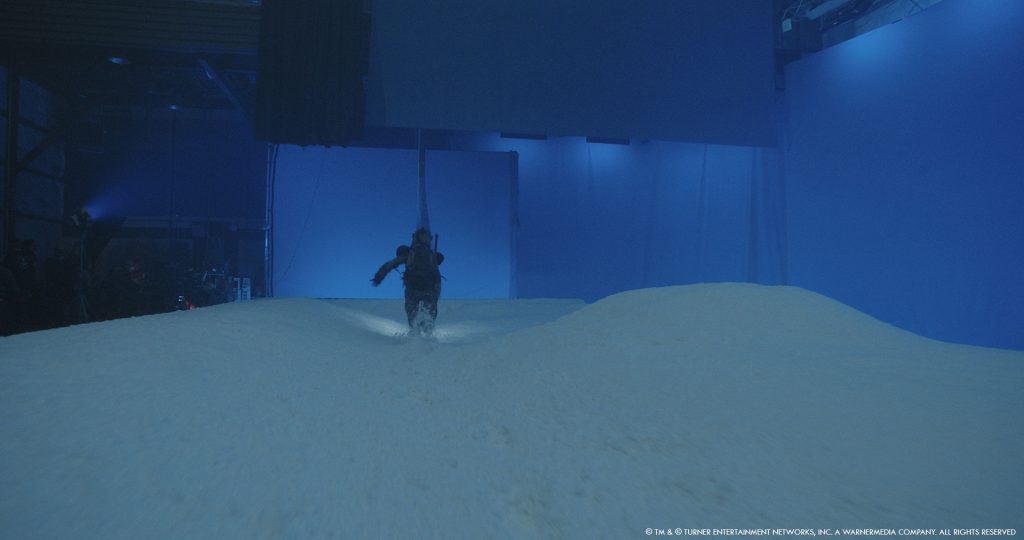
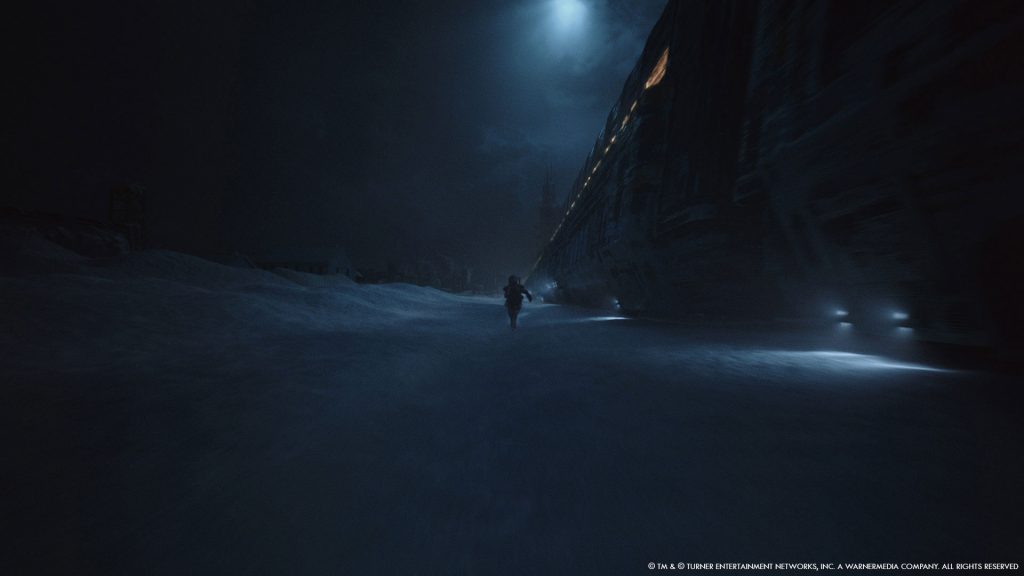
How was the work split amongst the FuseFX offices?
The bulk of the team and work was all done out of the Vancouver studio. Although we did have some help from the LA office. FuseFX does a very good job sharing their production and artist resources across all offices. Strategically, scaling our team when required was key. If a particular episode required more artists in a particular department our production managers did a stellar job sharing them from other offices instead of hiring. For example, LA offices have some amazing senior lighters that we were able to throw some work from time to time that worked in our benefit. We kept all of the compositing together in Vancouver.
Did the production want to change anything on the VFX side since the first season?
Yes, more VFX! In the first season we get a peek of what’s outside the train, as most of the story was contained to inside. In season 2 we venture out from the train many times. We were able to elaborate more on the frozen world beyond the train, and the VFX played a more substantial role in supporting the story. There are a few sequences we see outside the trains that would not have been possible to shoot anywhere or in a studio to achieve what we did with the train moving at such high speeds.
Can you explain in detail about the creation of the two trains?
The train designs were established in season 1 by concept designer Alex Nice with Geoff Scott. Snowpiercer is a pulling engine with 1001 cars and up to 2 stories in height. The Big Alice train is a pushing engine and is up to 3 stories in height. I believe the designs were partially influenced by various real world trains.
Can you tell us more about the shaders and textures creation?
The world of Snowpiercer is an ice age. Everything is frozen and covered by snow. Right from the start, we knew that it was essential for us to establish a pretty comprehensive shader and texture library. We already had established the trains from season one and needed to do the same for the environments and asset set props for season 2. Our CG supervisor Sean Ritchie and team worked on creating these shaders to work in different lighting situations using VRay. We were creating a visual mix of ice and snow, not the fresh powder wonderland type of snow. Creating these libraries gave us the ability to work smarter and faster when beginning new episodes. We did create some bespoke train textures and lighting for the opening Chicago City rail yard scenes in the first episode of season 2 where we see Melanie so close to the trains.
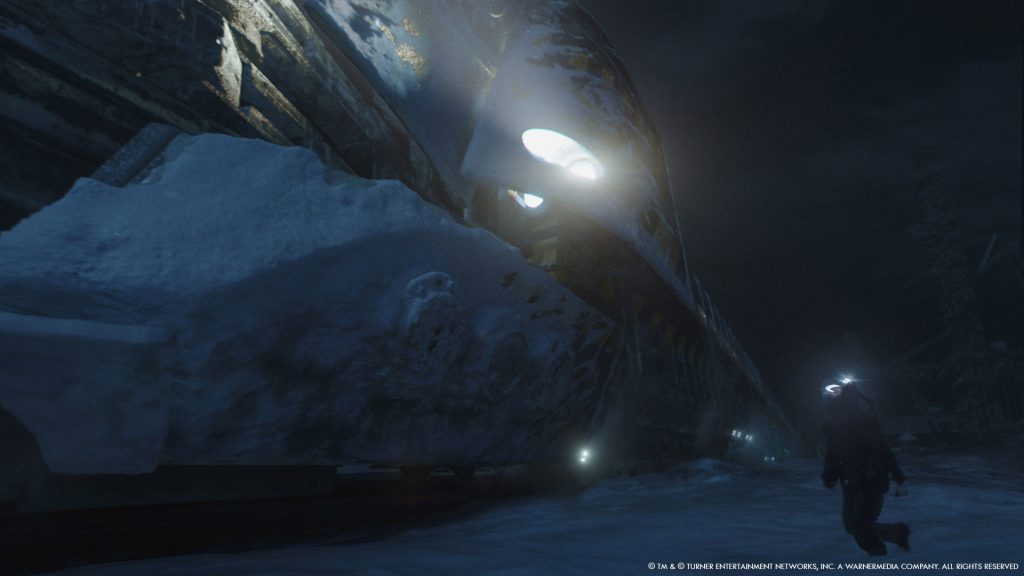
Did you use procedural tools for the train and its train cars?
The train’s procedural textures were created by Geoff Scott with another vendor at the beginning of season 1. We ingested these into our pipeline and created bespoke setups where needed for specific shots. We built tools that help us quickly and smoothly transfer our train cars from Previz/layout into shot build. These tools evolved over season 2 and helped us become more efficient at streamlining our shot build work.
Can you tell us more about the FX work on the snow and ice?
Our FX team did a stellar job with adding the glue here so the trains look and feel grounded into the environments. FX produced simulations for the trains when they plow through snow as well as atmos simulations. We also used FX simulations for icicles attached to environment structures that would break when trains pass. There were also multiple simulations for general snow in the air wrapping around the trains and sweeping off mountain peaks. Many bespoke sims were created for one off shots of fog freezing effects and steam omitting from the trains. Brody Fikkert, our FX TD, established a pretty good comprehensive sim library of renders over the 2 seasons that comp were able to quickly choose when lookdeving shots in Nuke for general passing anomaly snow.
What was your approach to create the huge frozen world?
It was led by creative! I looked at real world photo references and video footage then began mapping out concept art to get conversations happening with Geoff and the showrunners. My team and I together would be looking at references daily breaking down why something looks and acts in a particular way. Once we were all happy with the look and direction, Frank Belina, our Layout Previz supervisor, would take the art and jump into cameras and blocking. We tried something new using GAEA, a procedural terrain builder that was new to our pipeline. We took the lessons we learned in season 1 and figured out a faster way for mass creation of environments. GAEA was our answer. Our lighting & lookdev artists then could export these landmasses into shot, and work on refinement and dressing into their specific shots with props and train interaction. GAEA was a very quick tool for us to implement into our pipeline where then our lookdev artists would pick up. Besides the FX atmos simulations, our DFX supervisor, Henrique Moser, created a very cool library of procedural snow, motes and mist pocket setups that lived in Nuke. Compositing could then use these scripts to populate the levels of atmos required per episode into our shots. Establishing good references, concepts and key art in combination with our library setups were key to our workflow.
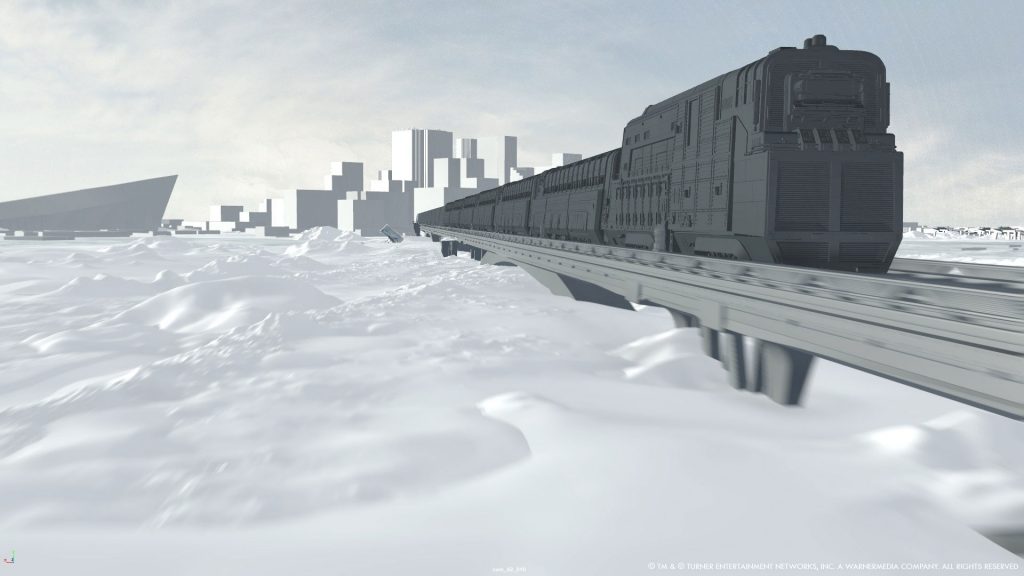
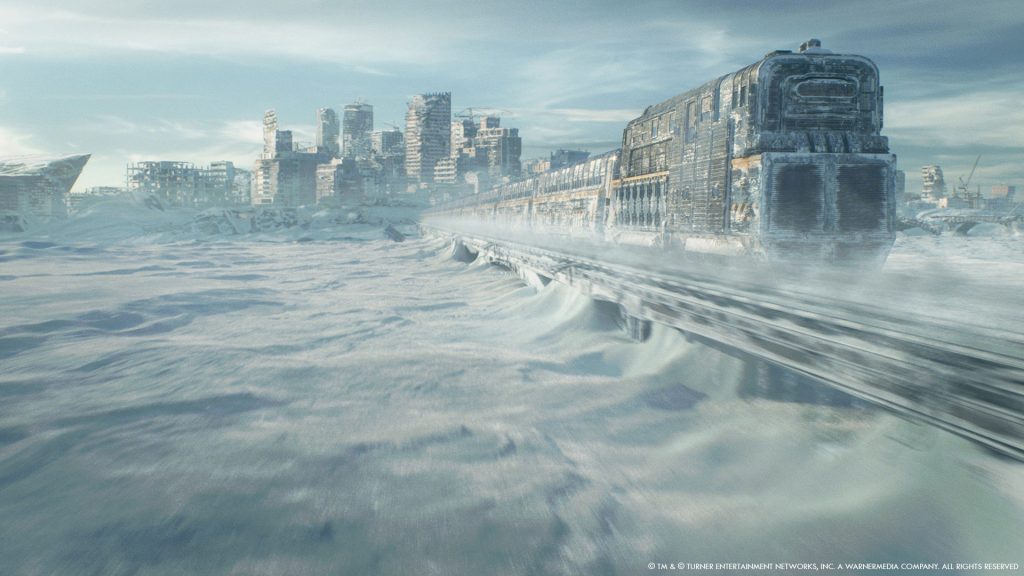
How does the frozen world and the sequences by night affect the lighting work?
It hugely affects it. Snow at night technically has a very different look about it than in the daylight. It’s much brighter with a particular visual glow to it. We spent some time lookdeving this until we created the look we were happy with.
Which sequence or shot was the most challenging?
In a later episode we see exterior wide views of the trains traveling down and around a canyon corkscrew at night. It was a technical challenge to place so many cars at one time into the shots. But after many conversations with some great minds the end result was less scary than we initially thought.
Did you want to reveal any other invisible effects?
There are many, for instance some of the interior work of the trains is extended. The set design is brilliant, and we kept the look and extended some of the car interiors.
Is there something specific that gives you some really short nights?
Excitement when it all comes together!
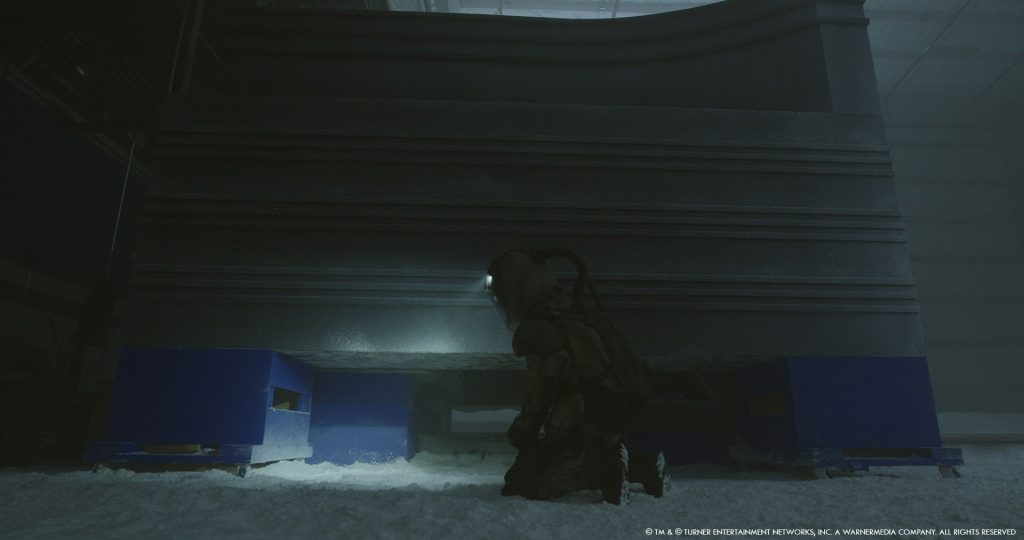
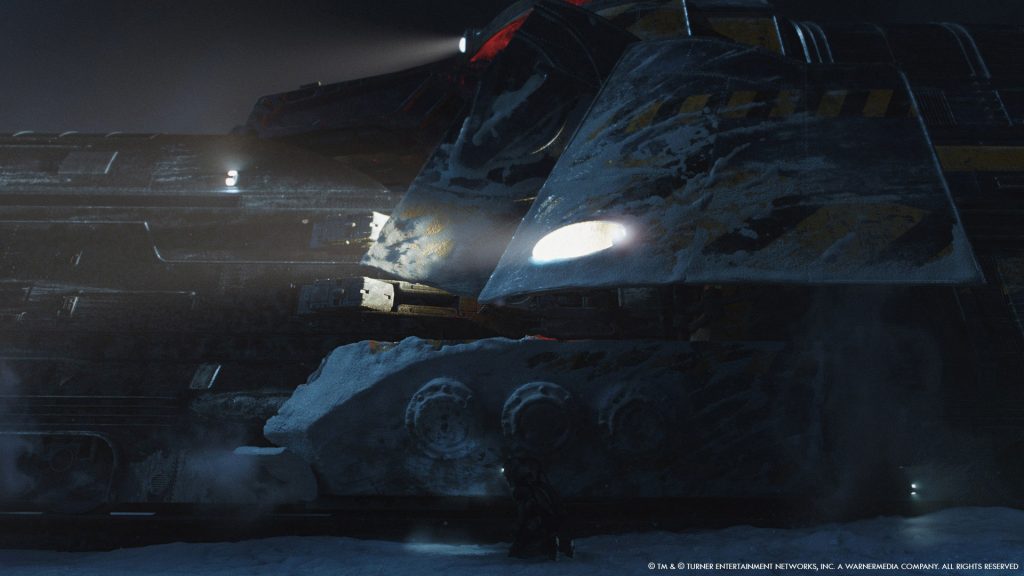
What is your favorite shot or sequence?
There are a lot, but one of them is the Vista shot establishing the frozen city of Minneapolis. Also, the opening sequence in episode 1 season 2 with Melanie. I also loved a sequence later in around episode 7 where we see a dangerous story beat where something happens to the exterior of the train.
What is your best memory on this show?
Besides all the amazing and talented people I met and worked with that come from different corners of the world, it’s when all our hard work comes together. It’s amazing getting to see something and thinking wow that’s pretty sweet, this is what we’re here for!
How long have you worked on this show?
1 year and 1 month.
What’s the VFX shots count?
Around 500 shots.
What was the size of your team?
A tight elite team of around 50.
What is your next project?
Unfortunately, it’s too early to talk about it because of confidential reasons.
What are the four movies that gave you the passion for cinema?
Jason and The Argonauts
The Empire Strikes Back
Raiders of The Lost Ark
John Carpenter’s The Thing
A big thanks for your time.
WANT TO KNOW MORE?
FuseFX: Dedicated page about Snowpiercer – Season 2 on FuseFX website.
© Vincent Frei – The Art of VFX – 2021
Get ready for tons of iconic shots and superheroes in full action in the VFX Reel by Scanline VFX showing the best of their work on Zack Snyder’s Justice League (click on the picture below to watch it):
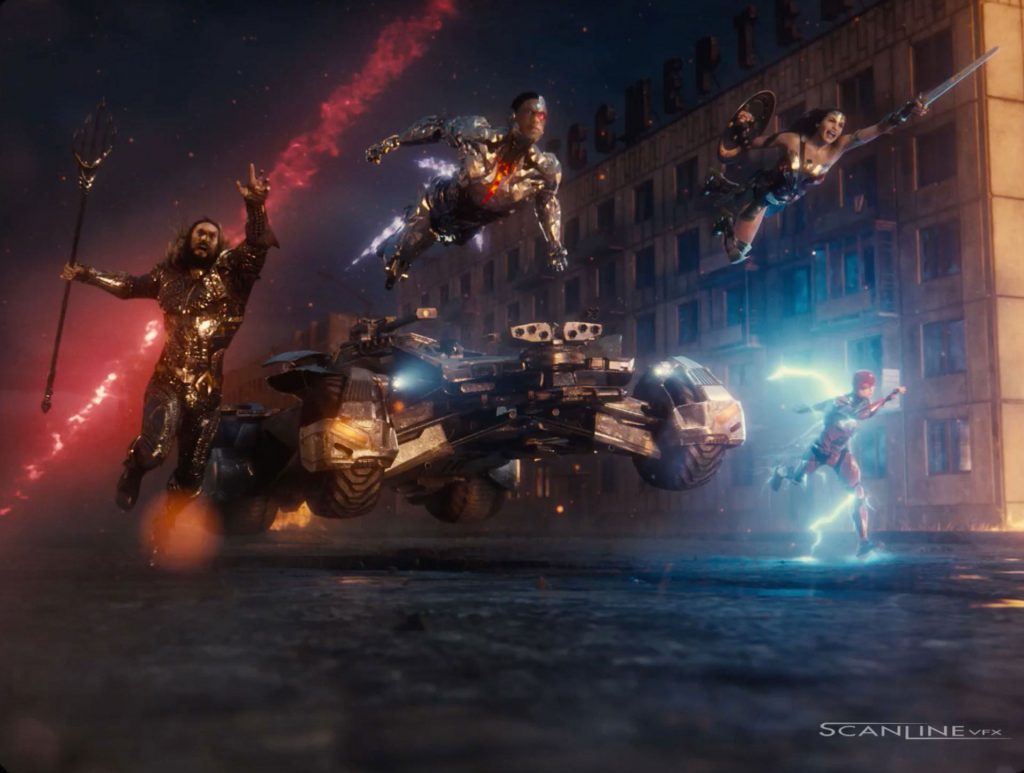
© Vincent Frei – The Art of VFX – 2021